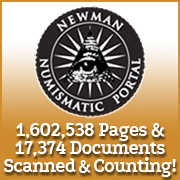
About UsThe Numismatic Bibliomania Society is a non-profit organization devoted to the study and enjoyment of numismatic literature. For more information please see our web site at coinbooks.org SubscriptionsThose wishing to become new E-Sylum subscribers (or wishing to Unsubscribe) can go to the following web page link MembershipThere is a membership application available on the web site Membership Application To join, print the application and return it with your check to the address printed on the application. Print/Digital membership is $40 to addresses in the U.S., and $60 elsewhere. A digital-only membership is available for $25. For those without web access, write to: Terry White, Treasurer AsylumFor Asylum mailing address changes and other membership questions, contact Terry at this email address: terrywhite5475@yahoo.com SubmissionsTo submit items for publication in The E-Sylum, just Reply to this message, or write to the Editor at this address: whomren@gmail.com BUY THE BOOK BEFORE THE COINSale Calendar |
- WAYNE'S WORDS: THE E-SYLUM FEBRUARY 11, 2018
- NEW BOOK: IRISH TAVERN TOKENS, 2017 EDITION
- BOOK: CHATS ABOUT OLD INVOICES
- NEW PERIODICAL: CPG MARKET REVIEW
- BOOK REVIEW: THE SILVER OF FAIRYLAND
- NGC UPDATES COUNTERFEIT DETECTION RESOURCE
- NEWMAN PORTAL ADDS SCRIP TALK
- NEWMAN PORTAL ADDS TAX TOKEN NEWSLETTER
- NEWMAN PORTAL SEARCH: ROBINSON HARTFORD
- VISUAL SEARCH FOR NUMISMATICS?
- PICTURED ROCKS QUARTER LAUNCHED
- BETH DEISHER, COIN WORLD, AND JOURNALIST ETHICS
- NOTES FROM E-SYLUM READERS: FEBRUARY 11, 2018
- MORE ON THE STONE MOUNTAIN COUNTERMARKS
- RUSTED RUPEES AND THE ROYAL MINT'S STEEL COINS
- GENDER NUMISMATICS WORKSHOP
- CSNS SCHEDULES SEXUAL HARASSMENT SPEAKER
- CSNS CONVENTION HOTEL ALMOST SOLD OUT
- VOCABULARY TERMS: DIE CAVITY, HIGH POINT
- STANISLAUS VINCENT HENKELS (1854-1926)
- HARVEY STACK'S NUMISMATIC FAMILY, PARTS 10-11
- TREASURY LAW ENFORCEMENT ON STRANGE INHERITANCE
- WHAT HAVE YOU FOUND IN OLD BOOKS?
- FRED HOLABIRD'S TUCSON GOLD RUSH EXHIBIT
- ARCHIVES INTERNATIONAL SALE 47
- NUMISMATIC NUGGETS: FEBRUARY 11, 2018
- MARK ANTONY’S LEGIONARY DENARIUS
- MUSLIM COIN FEATURES MENORAH SYMBOL
- ARCHEOLOGY AS A POLITICAL WEAPON
- MORE IMAGES OF ISIS COINAGE?
- HAS THE UNFAKABLE POUND COIN BEEN FAKED?
- 1904 ST. LOUIS OLYMPIC PARTICIPATION MEDAL
- THE 2018 WINTER OLYMPIC MEDALS
- UKRAINE'S 2018 WINTER OLYMPICS HOLOGRAPHIC COIN
- 1912 WOMEN'S HUNGER STRIKE MEDAL
- VIDEO: STRIKING THE WOMEN'S SUFFRAGE 50 PENCE
- HISTORIC BANK OF ENGLAND PAPER MILL DESTROYED
- NIGERIAN ARTIST DRAWS BANKNOTES
- SRI LANKA'S NEW DIVERSITY BANKNOTE
- MALAWI PRAYS PEOPLE WILL STOP ABUSING BANKNOTES
- BELGIAN STATUE SOAKS UP KNOWLEDGE
- IN OTHER NEWS: FEBRUARY 11, 2018
- FEATURED WEB SITE: ORIENTAL COINS DATABASE
Click here to access the complete archive
To comment or submit articles, reply to whomren@gmail.com
Content presented in The E-Sylum is not necessarily researched or independently fact-checked, and views expressed do not necessarily represent those of the Numismatic Bibliomania Society.
WAYNE'S WORDS: THE E-SYLUM FEBRUARY 11, 2018
 New subscribers this week include: Steve Cawood, courtesy of David Schenkman, Richard Mountain, courtesy of Jim Contursi, Lilian Guerra, and Richard Wefering. Welcome aboard! We now have
3,684 subscribers.
New subscribers this week include: Steve Cawood, courtesy of David Schenkman, Richard Mountain, courtesy of Jim Contursi, Lilian Guerra, and Richard Wefering. Welcome aboard! We now have
3,684 subscribers.
Thank you for reading The E-Sylum. If you enjoy it, please send me the email addresses of friends you think may enjoy it as well and I'll send them a subscription with your compliments. Contact me at whomren@gmail.com anytime regarding your subscription, or questions, comments or suggestions about our content.
This week we open with two books, a new periodical, one review, and updates to the NGC and Newman Numismatic Portal web sites. Other topics this week include tax tokens, Alfred S. Robinson, visual search, the Pictured Rocls quarter launch, the Royal Mint's steel coins, die cavities and high points, the Legionary denarius, menorahs on Muslin coins, hunger strike medals, and Olympic medals, coins and tokens.
To learn more about Irish tavern tokens, the Silver of Fairyland, the top world counterfeits, coal company scrip and tokens, U.S. Mint Sculptor-Engraver Michael Gaudioso, Royal Mint history, the Anti-Corn Law League medal, Sri Lanka's Diversity banknote and gender numismatics, read on. Have a great week, everyone!
Wayne Homren
Editor, The E-Sylum
NEW BOOK: IRISH TAVERN TOKENS, 2017 EDITION
 The Numismatic Society of Ireland has received permission from Fr. Gerry Rice to publish a full colour and hardback edition of Irish Tavern Tokens . The 2013 edition is the
result of many years research based on the John Sweeney collection of tavern tokens which has been supplemented by tokens from other collections. The result is the most comprehensive publication of
Irish tavern tokens to date and it brings new dimensions to the study of this branch of numismatics. Following its softback publication in 2013 the book has become the definitive source for these
tokens and is cited by leading auction houses and researchers.
The Numismatic Society of Ireland has received permission from Fr. Gerry Rice to publish a full colour and hardback edition of Irish Tavern Tokens . The 2013 edition is the
result of many years research based on the John Sweeney collection of tavern tokens which has been supplemented by tokens from other collections. The result is the most comprehensive publication of
Irish tavern tokens to date and it brings new dimensions to the study of this branch of numismatics. Following its softback publication in 2013 the book has become the definitive source for these
tokens and is cited by leading auction houses and researchers.
Irish Tavern Tokens is written for numismatists, be they collectors or students of the subject, and it illustrates 350 examples from a catalogue of over 400 Irish tavern tokens. Most were struck by the company controlled by John Craig Parkes at the Coombe in Dublin. Individual tokens are fully described and are cross-referenced to other popular tavern token catalogues. When known, the provenance of an individual token is listed. Each piece, including the issuing proprietor, has been carefully researched and recorded and where a ‘social context’ is understood, that too is included, making the finished volume a comprehensive commentary on the licensed trade as evidenced by the tavern tokens of post-famine Dublin. For easy reference the book includes an index of types, an index of places and an index of issuers.
The publication price of the book is €39.00 and it is being offered to the trade and bulk buyers at a discounted price of 3 for €90.00, 6 for €180 or 9 for €270. There is no VAT on books
Postage is available to any destination worldwide (at cost). All orders dispatched within 48 hours
This updated hardback colour edition of Irish Tavern Tokens was launched at the May 2017 meeting of the Numismatic Society of Ireland. Half of the print run was presold. Supplies are limited and when they are gone, that’s it!

Description
Full colour hardback; xii; 113p; 25cm; ISBN 978-0-902605-02-2 This special edition is hardbound in a black cover with silver foil lettering on front and spine. Printed on gloss paper.
Citation
RICE, G. (2017) Irish Tavern Tokens: The John Sweeney Collection supplemented by other collections, with a supplement by Garry Byrne, Numismatic Society of Ireland & National Museum of Ireland,
Collins Barracks, Dublin.
Irish Tavern Tokens is jointly published by the Numismatic Society of Ireland and The National Museum of Ireland, Collins Barracks and is recommended as an essential reference for all Irish numismatics libraries
Since the first edition of the book was published, additional tavern tokens have come to light, mainly through auctions at eBay, Whyte’s and Dix Noonan Webb (DNW) and a very small number in private collections. Some of these were published in the Numismatic Society of Ireland’s (NSI) Bulletin.
These new tokens are now combined with examples from Barry Woodside’s (BW) website of Tavern Tokens, where he uses Todd reference numbers, and are presented here as the First Supplement to the original catalogue.
The Supplement was written by Garry Byrne and is divided into two parts – Additions to the Catalogue and a Descriptions Supplement. In the Additions to the Catalogue new tokens not listed originally in the catalogue are illustrated, numbered and described with information that is now available. New and additional details relating to tokens already listed in the catalogue are presented in the Descriptions Supplement.


To view Barry Woodside’s Tavern Tokens, see:
http://www.irish-tokens.co.uk/tavern/tavern-page.htm
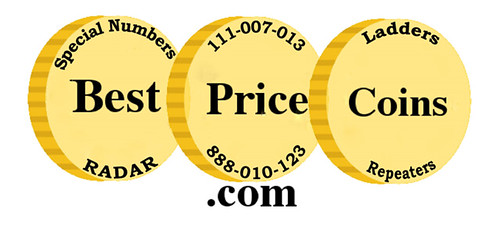
BOOK: CHATS ABOUT OLD INVOICES
Styling itself as “the only online invoice museum in China” and hosted on the Hebei Taxpayers website, The Invoice Museum ????? is a digital catalogue of part of a private collection of over 2000 invoices. The collection belongs to Mr GAO Xianzhou ??? who works in tax in Hebei province.
Gao started collecting invoices in 2000, and his collection includes pieces from the Qing dynasty and Republican period. In the screenshot above, the note at top-left is dated 1722 (Kangxi 61). As his collection grew, and he developed expertise, Gao wrote Chats about Old Invoices «?????», published by the China Tax Publishing House in May 2007. He is currently writing a new book – A Hundred Years of Invoices in China «??????» – about the evolution and development of invoices in more recent times.
To visit THE INVOICE MUSEUM, see:
http://www.hbnsr.cn/web/invoiceList.aspx
To read the complete article, see:
THE INVOICE MUSEUM (https://chinesemoneymatters.wordpress.com/2018/02/05/the-invoice-museum/)
NEW PERIODICAL: CPG MARKET REVIEW
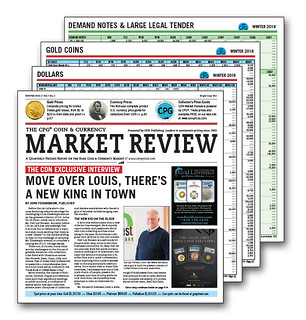 Created specifically for collectors, the Collector's Price Guide Coin & Currency Market Review contains over 96 pages with price listings for nearly every U.S. coin and currency
series, in grades from Good to MS65, and higher.
Created specifically for collectors, the Collector's Price Guide Coin & Currency Market Review contains over 96 pages with price listings for nearly every U.S. coin and currency
series, in grades from Good to MS65, and higher.
• Every issue features a relevant exclusive interview with an important collector or dealer in the industry
• Published four times a year (Jan, Apr, Jul, Oct)
• CPG prices based on the industry-standard Greysheet & Greensheet wholesale publications
• An indispensable part of every collector’s reference library
1 issue for $10; 4 issue for $29.99/year. Visit www.greysheet.com to order online, or call our team at 757-656-1055

For more information, see:
https://www.greysheet.com/
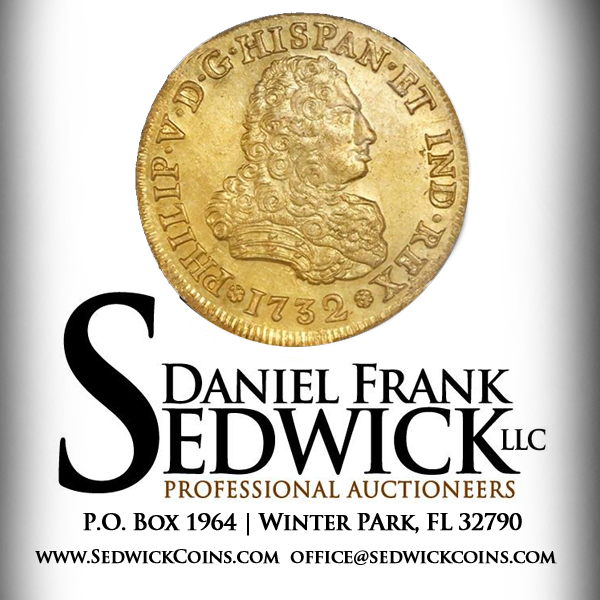
BOOK REVIEW: THE SILVER OF FAIRYLAND
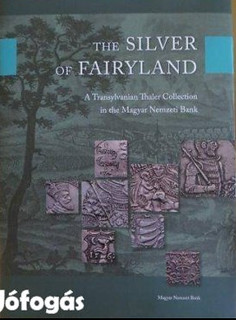 My very good friend and fellow collector Balazs Csanady gave me a wonderful new book as a Christmas present, The Silver of Fairyland, a book on a 220 piece Transylvanian Thaler
collection purchased by the Hungarian National Bank (Magyar Nemzeti Bank). It was published simultaneously in the Hungarian and English languages. It has 240 pages; Csaba Toth is the Editor in
Chief.
My very good friend and fellow collector Balazs Csanady gave me a wonderful new book as a Christmas present, The Silver of Fairyland, a book on a 220 piece Transylvanian Thaler
collection purchased by the Hungarian National Bank (Magyar Nemzeti Bank). It was published simultaneously in the Hungarian and English languages. It has 240 pages; Csaba Toth is the Editor in
Chief.
It had been collected by three generations of the Toro family. It is a beautiful book. All 220 pieces are plated, and illustrations are on almost every page. Each Prince that issued coins in this collection has a full page picture. It states that a decision was to build the collection with die varieties, especially of the Princes that had longer reigns, and issued numerous varieties. An interesting history is given of the purchases through the years.
There are seven different chapters, each written by a different numismatist. One of them has thirteen pages of plates of 17th century coin dies from the Brasso (Kronstadt) mint.
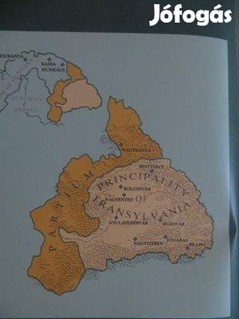
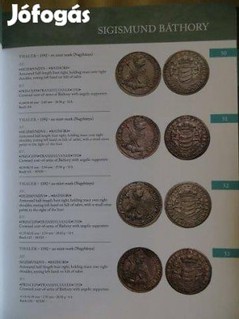
For more information, see:
A Transylvanien Thaler Collection book " The Silver of
Fairyland" (https://www.jofogas.hu/budapest/A_Transylvanien
_Thaler_Collection_book___The_Silver_of_Fairyland__74436935.htm)
dave adds:
www.coins.hu has the Hungarian edition for 26.25 Euro.
NGC UPDATES COUNTERFEIT DETECTION RESOURCE

Numismatic Guaranty Corporation® (NGC®) has expanded its online Counterfeit Detection resource to include detailed descriptions of its world coins most commonly targeted by counterfeiters.
 Number one on the list is a Russian gold coin: the Russia 1897AT 15 Roubles. Despite a mintage of 12 million pieces, counterfeits are frequently seen by NGC graders. Transfer-die
counterfeits of this coin are among the most common, so collectors and dealers should look for repeating depressions (marks that appear on multiple counterfeit coins in the exact same locations).
Number one on the list is a Russian gold coin: the Russia 1897AT 15 Roubles. Despite a mintage of 12 million pieces, counterfeits are frequently seen by NGC graders. Transfer-die
counterfeits of this coin are among the most common, so collectors and dealers should look for repeating depressions (marks that appear on multiple counterfeit coins in the exact same locations).
The list of the 25 world coins most often targeted by forgers, according to submissions to NGC, includes six coins from Great Britain, as well as ones from Canada, Eritrea, French Indochina, Japan, Iran, Italy, Korea, Russia, Saudi Arabia, Turkey and Vietnam.
NGC's graders have identified more than 100,000 counterfeit and altered coins since 1987.
To visit the NGC Counterfeit Detection site, see:
https://www.ngccoin.com/resources/counterfeit-detection/
To read the complete press release, see:
NGC Helps Collectors and Dealers Identify Top World Counterfeits
(https://www.ngccoin.com/news/article/6239/counterfeit-world-top-25/)
To read the earlier E-Sylum article, see:
NGC OPENS COUNTERFEIT DETECTION PORTAL (http://www.coinbooks.org/v20/esylum_v20n42a07.html)
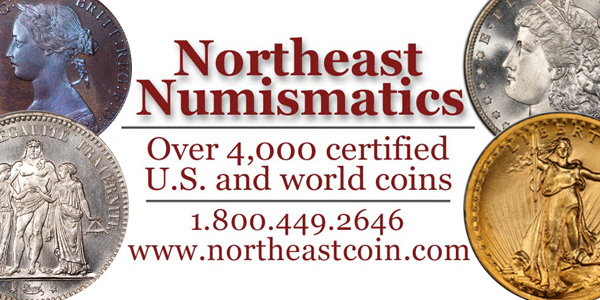
NEWMAN PORTAL ADDS SCRIP TALK
 Founded in 1972, the National Scrip Collectors Association (NSCA) is dedicated to the study of coal company scrip and tokens, and the history of coal mining companies as it relates to the
usage of these items. The NSCA issues a quarterly publication, Scrip Talk, which includes club news, original research, and member advertisements. A recent issue (Summer 2017) includes an
article by David Schenkman on tokens of the Union Mining Company in Maryland. While U.S. coal production is declining, these numismatic items remain to document a significant slice of American
economic history.
Founded in 1972, the National Scrip Collectors Association (NSCA) is dedicated to the study of coal company scrip and tokens, and the history of coal mining companies as it relates to the
usage of these items. The NSCA issues a quarterly publication, Scrip Talk, which includes club news, original research, and member advertisements. A recent issue (Summer 2017) includes an
article by David Schenkman on tokens of the Union Mining Company in Maryland. While U.S. coal production is declining, these numismatic items remain to document a significant slice of American
economic history.
Newman Portal has added Scrip Talk to its periodical section, and is grateful to NSCA president Steve Cawood, Scrip Talk editor Kevin Andersen, and NSCA members Billy Campbell and Mike Williams for their assistance.
Link to Scrip Talk on Newman Portal:
https://nnp.wustl.edu/library/publisherdetail/523668
Link to National Scrip Collectors Association home page:
http://nationalscripcollectors.org/
NEWMAN PORTAL ADDS TAX TOKEN NEWSLETTER
 American Tax Token Society President John Ostendorf writes:
American Tax Token Society President John Ostendorf writes:
Thanks to Len Augsburger and the fine folks at the Newman Numismatic Portal, I am very pleased to announce that the first 150 issues (1971-2010) of the American Tax Token Society Newsletter are now available on the Newman Numismatic Portal. I'd like to express our sincere thanks to Len and his team. The NNP is flat out awesome!
Link to ATTS Newsletter on Newman Portal:
https://nnp.wustl.edu/library/publisherdetail/524434

NEWMAN PORTAL SEARCH: ROBINSON HARTFORD
This week a Newman Portal user searched for “Robinson Hartford Numismatist.” Pete Smith’s American Numismatic Biographies quickly identifies Alfred S. Robinson (1836-1878) of Hartford, CT, who commissioned copies of colonial rarities in addition to personal trade cards. From there we find mention, in a Fred Lake literature sale, of the monograph Alfred S. Robinson-Hartford Numismatist, published by the Connecticut Historical Society in 1968. Lake describes the work as a “28 page treatise on Robinson who began, in 1860, to produce copies of many of the most famous numismatic treasures-fully illustrated.”
While Newman Portal does not have a copy of the monograph, we now know that it exists and that a copy can be found in the Connecticut Historical Society library. Newman Portal further identifies other pieces attribution to Robinson, such as an 1860 medal honoring Fulton’s steamboat, cataloged in Collector’s Auctions, Ltd. sale of March 1988 (lot 302). Many of the 19th century copies are well-done and today collectible in their own right, and collectors studying Robinson pieces will find extensive related information via the Newman Portal.
Link to Pete Smith’s American Numismatic Biography database on Newman Portal:
https://nnp.wustl.edu/library/people
Link to Fred Lake literature sales on Newman Portal:
https://nnp.wustl.edu/library/auctioncompanydetail/511123
Link to Johnson and Jensen (later Collector’s Auction, Ltd.) catalogs on Newman Portal:
https://nnp.wustl.edu/library/auctioncompanydetail/511036
VISUAL SEARCH FOR NUMISMATICS?
Magnus, the app dubbed “Shazam for Art”, today announced it has closed a Series A investment round from a group of investors, including Leonardo DiCaprio, who also joins as an advisor to the company.
Magnus follows a similar concept to the popular audible-based search company Shazam. Users upload a photo of an artwork and the app returns the details, such as the artist’s name, title of the work and price. Magnus’ leading technology covers over 20,000 galleries, museums, and auction houses around the world. Its database consists of over 10 million images. The app can be downloaded for free in the Android and Apple app store.
The Magnus app aims to democratize the $44 billion global art market, which, according to the TEFAF Art Market Report 2017, has only slowly embraced technology with an online share of only 8.4%.
“Our goal is to make the art market more transparent, open and honest. We love working with our great investors who are passionate about our mission and are equally experienced in the market,” said Magnus Resch, founder and CEO. “In 12 months we have grown our user base to become one of biggest apps in the art world. This funding allows us to continue our international expansion and offer new services for art lovers.”
To read the complete article, see:
Leonardo DiCaprio invests in Magnus app
(http://artdaily.com/news/102304/Leonardo-DiCaprio-invests-in-Magnus-app#.WoB16-jwaAs)

PICTURED ROCKS QUARTER LAUNCHED
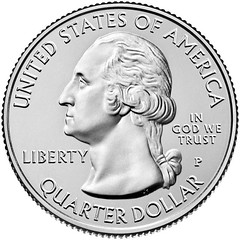
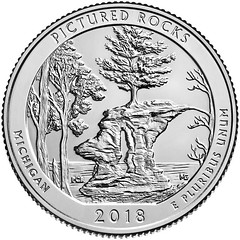
The United States Mint (Mint) joined the National Park Service (NPS) today to celebrate the release of the America the Beautiful Quarters® Program coin honoring Pictured Rocks National Lakeshore in Michigan. The coin is the first of five America the Beautiful Quarters to be issued in 2018, and the 41st release in the series.
The reverse (tails) of the Pictured Rocks National Lakeshore quarter depicts Chapel Rock and the white pine tree that grows atop it. Inscriptions are “PICTURED ROCKS,” “MICHIGAN,” “2018,” and “E PLURIBUS UNUM.”
“This new coin not only reflects one of the many unique features of the longest freshwater coastline in the United States, but also the breathtaking natural beauty of the state,” said Marc Landry, a Michigan native and Acting Associate Director of the Mint’s Numismatic and Bullion Directorate.
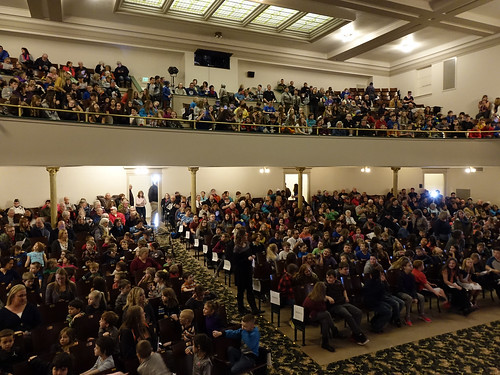
 More than 450 schoolchildren, along with local residents, gathered in the Mather Elementary School auditorium for the ceremony, led by Katherine Reynolds, Executive Director of the Greater
Munising Bay Partnership for Commerce Development, the Alger County Chamber of Commerce and the Munising Downtown Development Authority. Additional ceremony participants included Timothy Williams,
Deputy Director of External Affairs at the Department of the Interior, on behalf of Interior Secretary Ryan Zinke; Jay Gage, Upper Peninsula Regional Manager, on behalf of Senator Debbie Stabenow;
Katelyn Rader, Upper Peninsula Regional Coordinator, for Senator Gary Peters; David Horne, Superintendent of Pictured Rocks National Lakeshore; and the Munising High School Concert Choir, which
provided pre- and post-event music. Paul Balan, Mint Artistic Infusion Program designer of the quarter, received special recognition during the ceremony which culminated in an exchange of $10 rolls
of newly minted quarters.
More than 450 schoolchildren, along with local residents, gathered in the Mather Elementary School auditorium for the ceremony, led by Katherine Reynolds, Executive Director of the Greater
Munising Bay Partnership for Commerce Development, the Alger County Chamber of Commerce and the Munising Downtown Development Authority. Additional ceremony participants included Timothy Williams,
Deputy Director of External Affairs at the Department of the Interior, on behalf of Interior Secretary Ryan Zinke; Jay Gage, Upper Peninsula Regional Manager, on behalf of Senator Debbie Stabenow;
Katelyn Rader, Upper Peninsula Regional Coordinator, for Senator Gary Peters; David Horne, Superintendent of Pictured Rocks National Lakeshore; and the Munising High School Concert Choir, which
provided pre- and post-event music. Paul Balan, Mint Artistic Infusion Program designer of the quarter, received special recognition during the ceremony which culminated in an exchange of $10 rolls
of newly minted quarters.
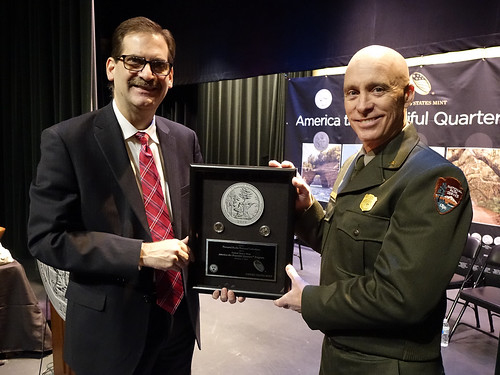
Marc Landry, Acting Associate Director of the Numismatic & Bullion Directorate, United States Mint, presents Pictured Rocks National Lakeshore quarters struck on the first day of production to Pictured Rocks National Lakeshore Superintendent David Horne
“America's public lands are full of postcard worthy places, like one of Michigan's best kept secrets, Pictured Rocks National Lakeshore,” said U.S. Secretary of the Interior Ryan Zinke. “With its awe-inspiring scenery and amazing year-round recreational opportunities, it is a testament that not all of our great public lands are located out West. Whether you want to hunt and fish or bike and kayak, its sandstone cliffs, towering waterfalls, hardwood forest, and miles of beaches offer something for all visitors.”
Authorized by Public Law 110-456 and launched in 2009, the America the Beautiful Quarters Program is a 12-year program that honors 56 national parks and other national sites. Each year until 2020, the public will see five new national sites depicted on the reverses of the America the Beautiful Quarters coins. A final coin will be released in 2021.
The Mint is issuing these quarters in the order in which each honored location was first established as a national site.
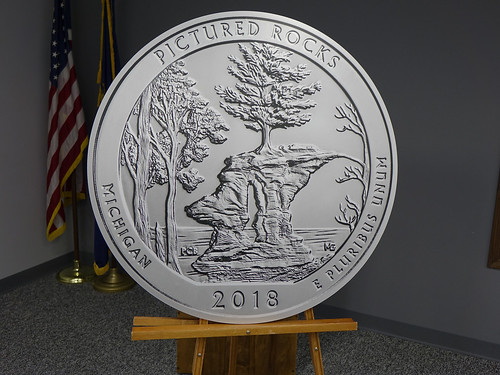
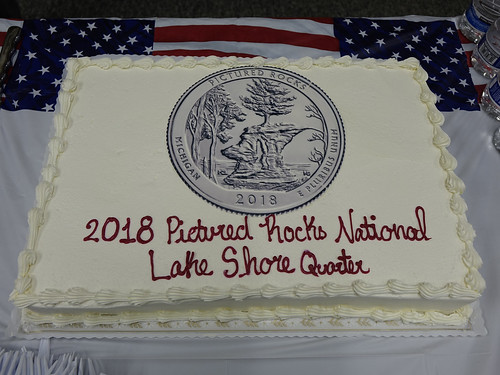
To read the complete press release, see:
United States Mint Launches 41st America the Beautiful Quarters® Program Coin
(http://www.prweb.com/releases/2018/02/prweb15181989.htm)
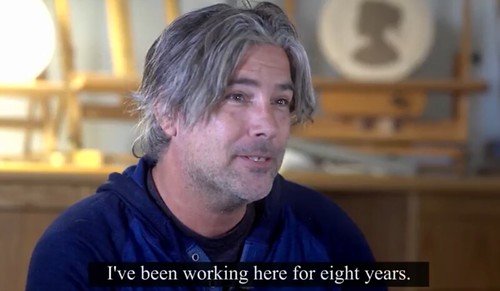
Sculptor-Engraver Michael Gaudioso discusses his work on the Pictured Rocks National Lakeshore coin, the first in the 2018 America the Beautiful Quarters collection.

To watch the complete videos, see:
Pictured Rocks National Lakeshore (2018)
(https://www.youtube.com/watch?v=mlL7xqf8pfc&list=PLoycqRjxZI6Y5A9igJnCtTuDMZhVoyM_9)
Pictured Rocks AtB B-Roll
(https://www.youtube.com/watch?v=rmG7xmYQuKw&index=2&list=PLoycqRjxZI6Y5A9igJnCtTuDMZhVoyM_9)
BETH DEISHER, COIN WORLD, AND JOURNALIST ETHICS
In reference to “Michael Marotta on John J. Ford” published in the Feb. 4, 2018, issue of The E-Sylum: Mr. Marotta is entitled to his opinions. However, he is not entitled to publish untruths. Facts are facts.
Fact: During the time I was employed at Coin World -- March 1, 1981, through April 30, 2012 -- there was never any litigation in which “all of the notebooks of the reporters [were] seized as evidence,” as Mr. Marotta claimed.
There was a libel suit filed against Coin World in January 1985 in which the notes and documents one writer used to prepare a series of news stories were subpoenaed as evidence. That suit was settled out of court in February 1992, with the only stipulation being that Coin World would publish a press release that had been offered two weeks after the suit was filed in 1985. That press release was published on Page 24 of the March 9, 1992, issue of Coin World.
Fact: Mr. Marotta was employed by Coin World from May 24, 1999, to May 5, 2000. His claim that Coin World “had just gotten through a lawsuit” when he joined the staff is at odds with the truth. The suit he referenced had been settled more than seven years prior to his hiring. Since he had virtually no prior experience in working for a weekly publication such as Coin World, during his orientation particular attention would have been paid to professional standards and ethics as well as to expected adherence to the publication’s policy guidelines.
Fact: Mr. Marotta’s assertion that I “permitted no criticism of John J. Ford, not just in print, but verbally in the office,” is patently false. The Guest Editorial, Point-Counter-Point, and Letters to the Editor columns, particularly during the years 1997 through 2000, in which many readers voiced opinions on both sides of the debate, often citing Mr. Ford by name, bear witness to Mr. Marotta’s disregard for the truth.
I did not issue an edict forbidding criticism of Ford due to any favoritism or loyalty to him personally. What I did do was to counsel and advise all who worked on the editorial staff to avoid discussions, particularly with readers and others in the numismatic community, of controversial topics and making statements about anyone (Mr. Ford included) that could be perceived as favoring one side over the other or conversely disparaging an individual or firm. I also cautioned against statements that could be construed as prejudicial against a person or firm that could lead to a claim of malice. Such an approach is prudent and well within the code of ethics for professional journalists and was indeed a part of Coin World’s policy guidelines.
There is good reason to keep an open mind and maintain neutrality as a journalist. At any given time one may be called upon to interview or report on events that involve people of differing views. Case in point: I covered and wrote Coin World’s news coverage of “The Great Debate” between Theodore V. Buttrey Jr. and Michael J. Hodder that took place Aug. 12, 1999, during the American Numismatic Association’s convention in Rosemont, Ill. Had I advocated for one side over the other before the debate, I would have been disqualified from reporting on the debate and Coin World would have lost credibility with its readers.
During my tenure as editor, if I had opinions about a particular subject, person, or event, they were expressed in written Editorials that carried my byline.
To read the earlier E-Sylum article, see:
MICHAEL MAROTTA ON JOHN J. FORD (http://www.coinbooks.org/v21/esylum_v21n05a19.html)
THE BOOK BAZARRE
NOTES FROM E-SYLUM READERS: FEBRUARY 11, 2018
Mrs. Buttrey’s Little Boy
David Fanning writes:
I’ve enjoyed reading the reminiscences of Ted Buttrey, a man I never met but with whom I corresponded regularly over the past several years. I don’t have much to add, but will contribute this little incident. Back in August, I asked Ted if I could send him a copy of the Memorias de la Academia Mexicana de Estudios Numismáticos that included his famous article no one here had the guts to publish. I asked if he would sign it and send it back. His response was, “Hell, man, I’m just Mrs. Buttrey’s little boy. But OK.”
He was a neat guy.
To read the earlier E-Sylum article, see:
DOUGLAS SAVILLE REMEMBERS THEODORE V. BUTTREY JR. (http://www.coinbooks.org/v21/esylum_v21n05a17.html)
Wanted: Popular Book on Private and Territorial Gold
In response to Dennis Tucker's request for ideas for new books in the firm's Bowers series, Eric Schena writes:
I have an idea for a book that I think would be very useful to the collecting community: a guide on Private and Territorial Gold, to include California fractional gold coins. The main references for these items are sometimes hard to find and usually very expensive, sometimes making even the details on these very fascinating coins relatively inaccessible. It seems to me that a decent guide in the Bowers series would be very helpful to foster interest in future generations.
I know as a kid, the private and territorial section of the Red Book was one of my favorite sections and it prompted me to get as many references as I could and try to acquire some of these coins and even though it is pretty much guaranteed that I will never own a $50 slug, I absolutely love reading about them. I think it would extremely beneficial to have the field opened up to a wide audience.
To read the earlier E-Sylum article, see:
WHITMAN SEEKS IDEAS FOR NEXT BOWERS SERIES BOOK (http://www.coinbooks.org/v21/esylum_v21n05a13.html)
 An Observation on the Four Generations Coin
An Observation on the Four Generations Coin
In the I'll-bet-you-didn't-think-of-that department, Chip Howell writes:
The E C W G on the 2018 Crown represents the four living generations of the British Royal family: Elizabeth II, & her descendants Charles III; William V; and George VII. *If* this is how succession plays out, that's four prime numbers in a row!
To read the earlier E-Sylum article, see:
2018 FOUR GENERATIONS ROYAL FAMILY COIN ISSUED (http://www.coinbooks.org/v21/esylum_v21n05a36.html)
Buick Encased Dime
Brad Karoleff writes:
Steve Bishop asked about General Motors encased dollars. I have two in the archives, one each of type one and two. My type one hosts a VF 1901-O Morgan and the type two has an AU 1884 plain Morgan, much like the one illustrated by Mr. Bishop.
Carol Bastable writes:
Although this is not a dollar, I thought it was rather interesting. I have seen the encased Buick dollars but did not realize that there were other denominations as well, until I saw this one on eBay. The auction closed about a week ago. I am not really an encased coin collector and did not bid on it but I do like oddities so I kept it on a watch list. Being a dime and Canadian definitely made it out of the ordinary.


To read the complete lot description, see:
1939 Encased Dime - General Motors of Canada - Bet Your Last Dime on Buick
1940 (https://www.ebay.com/itm/1939-Encased-Dime-General-Motors-of-Canada-Bet-Your-Last-Dime-on-Buick-1940-/362224362253)
To read the earlier E-Sylum article, see:
QUERY: BUICK, GENERAL MOTORS ENCASED DOLLARS (http://www.coinbooks.org/v21/esylum_v21n05a20.html)
2018 Winter Olympic Elongates
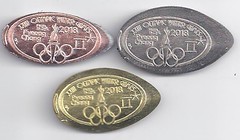
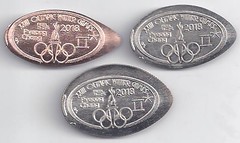
Sets #1 and #2
Oded adds:
I still have a few sets still available from the previous Olympic games. Please contact me for additional information & pricing.
Frank Robinson on the Great Mutilated Coin Scam
Frank Robinson writes:
I noticed the story about the Mint’s mutilated coin program. I wrote about this on my blog in 2015, and thought readers might find it amusing.
To read the complete article, see:
The Great Mutilated Coin Scam
(https://rationaloptimist.wordpress.com/2015/06/27/the-great-mutilated-coin-scam/)
To read the earlier E-Sylum article, see:
U.S. MINT RESUMES MUTILATED COIN PROGRAM (http://www.coinbooks.org/v21/esylum_v21n05a32.html)
Lincoln's Silver Dollar Bar Medal
Ken Barr writes:
There is a large (50 mm) silver-plated medal honoring the Silver Dollar Bar.
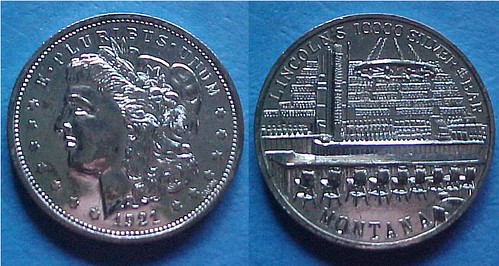
To read the earlier E-Sylum article, see:
LINCOLN'S WORLD FAMOUS 50,000 SILVER $ BAR (http://www.coinbooks.org/v21/esylum_v21n05a41.html)

MORE ON THE STONE MOUNTAIN COUNTERMARKS

John Okerson writes:
There were three relatively recent articles in The Numismatist on these coins:
March 1985 beginning on page 466
August 1987 beginning on page 1633
January 2011 beginning on page 36
Gary Greenbaum writes:
Regarding the Stone Mountain half, I found the source below very helpful when I was doing the (of course) Wikipedia article on it. I don’t recall if it was simply a reprint of what was in The Numismatist, or if more matter was added, but it was very good. The ANA library has it in their pamphlets file.
Hyder, William D.; Colbert, R.W. (1985). The Selling of the Stone Mountain half dollar. Colorado Springs, Col.: American Numismatic Association (pamphlet with reprint from March 1985 The Numismatist).
Bill Hyder writes:
R.W. Colbert and I wrote an article, The Selling of the Stone Mountain Half Dollar that appeared in the March 1985 Numismatist. We could not identify the G.L. and S.L. countermarks, but that was later solved by another researcher--Gold Lavalier or Silver Lavalier--coins in bezels awarded to the first and second place winners (young ladies) of the most sales of the halves in their areas. See Unraveling the Mystery of the Counterstamped Halves by A. Steve Deitert in the January 2011 Numismatist.
There are many other articles out there including Adna Wilde's censuses of known countermarked halves. These two articles were informed by original documents and brochures from the period. I suspect there are still gems of information waiting to be found.
Lee Gast writes:
I have been conducting research in hopes of writing a book around the 50 piece series of early commemorative coins. Last week a fellow Numismatist asked for information around Counterstamped Stone Mountain Half Dollars. Adna Wilde pretty much "wrote the book" around the counterstamps. Mr. Wilde's research can be found in The Numismatist, "Counterstamped Stone Mountain Half Dollars: Where Are They Today?" By Adna G. Wilde Jr., LM232, August 1987, p. 1633-1643. If this research can not be found online, the ANA can copy the pages for a small fee.
Hope this helps a fellow researcher,
Ken Bressett writes:
Regarding the request for information about the research Arlie Slabaugh did on counterstamped Stone Mountain half-dollars, Whitman published his book that included a good description of the pieces. If this work has been overlooked I suggest it is worth pursuing. Arlie was a careful researcher and writer, as well as a good friend to all who knew him.
United States Commemorative Coinage. Arlie R. Slabaugh. Whitman Publishing 1962, and second edition 1975. Hardcover 6”x9”. The second edition contains some additional information on the counterstamped pieces.
Tom Caldwell of Northeast Numismatics writes:
Bill Shamhart is a dealer in New Jersey who has dealt in some of the Stone Mountain counterstamped halves.
John Okerson adds:
There were three different medals issued in 1970 – a 70 mm Bronze with 500 made, a 70 mm .900 Silver with 1500 made and a 40 mm .900 silver with 1500 made.
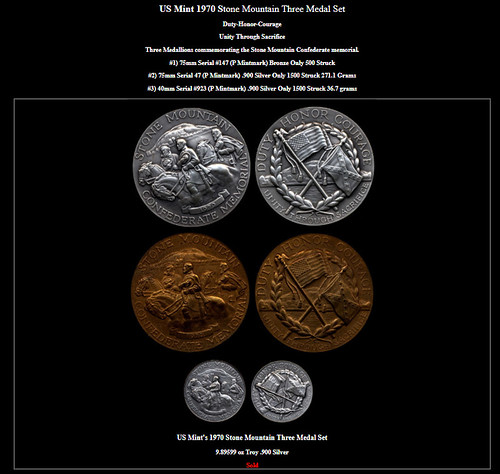
To read the earlier E-Sylum article, see:
QUERY: STONE MOUNTAIN COUNTERMARK INFO SOUGHT (http://www.coinbooks.org/v21/esylum_v21n05a08.html)
RUSTED RUPEES AND THE ROYAL MINT'S STEEL COINS
When I was a kid (say, in the 1950s and part of the 1960s), I found the rusted look of West German low-value coins (1, 2, 5 & 10 pfennig, say 1948-1952) VERY unappealing – and as a young man I disliked how a washer or steel disk could imitate such a coin quite well, plus how a magnet could interfere with such pieces in a slot machine.
I was therefore HORRIFIED when the Royal Mint started to introduce steel-cored coins for the UK (and some of the other countries which it produces coins) starting in September 1992 for 1 & 2 pence coins, and January 2012 for 5 & 10 pence coins.
An article in "The Telegraph" of 03 Sep 2010 describes the proposal for such plated-steel 5 & 10 pence coins as a 'disaster', from the point of view of slot machines and conversion cost.
So, quite frankly, I am not surprised that these Seychelles coins have been giving trouble within weeks of their introduction and that within 14 months of their introduction it had become necessary to replace them.
"Simon Lake, Director of Sales of the Royal Mint, ... added that this is the first time that the Royal Mint ... encountered such an issue after 150 years of service."
This is a totally specious argument/statement, and I'd have hoped that the Royal Mint would not stoop to making such misleading comments – it is only within the last 25 years or so that the the Royal Mint had been using a material capable of rusting!
Also, Mr Lake (if quoted accurately) shows a worrying lack of knowledge of the organisation, implying that it had been going only from c.1867, even though many people know that it moved from the Tower of London (where it had been for centuries) to a site in Tower Hill about 210 years ago. Perhaps he should take a look at (among other places), his own Royal Mint Museum's history at the Tower of London.
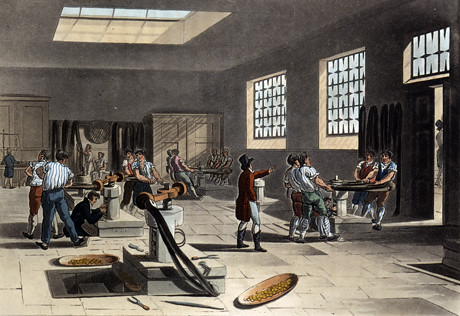
One of the coining press rooms in the Tower of London, c.1809
To read the Telegraph article, see:
New steel 5p and 10p coins a 'disaster'
(http://www.telegraph.co.uk/finance/personalfinance/bank-accounts/7979997/New-steel-5p-and-10p-coins-a-disaster.html)
To read the Royal Mint Museum's history at the Tower of London, see:
The Tower of London
(http://www.royalmintmuseum.org.uk/history/the-royal-mint-story/the-tower-of-london/index.html)
To read the earlier E-Sylum article, see:
REPLACING THE RUSTED RUPEES OF SEYCHELLES (http://www.coinbooks.org/v21/esylum_v21n05a33.html)

GENDER NUMISMATICS WORKSHOP

International Workshop, University of Tübingen, November 29-30, 2018
Recent archaeological studies have acknowledged that the function and meaning of ancient material culture is both resulting in and generative of habits, values, norms, and behaviors in a given society requiring a new set of interpretative methodologies. To that end, gender studies can become part of the research agenda.
In one particular area of ancient, especially Greco-Roman material culture, these research strands have not received the attention they deserve: coinage. Yet, the polyvalence of ancient coins provides an unequalled opportunity to enhance our understanding of the complexity and dynamics of gender roles in the Mediterranean World. As medium of exchange (in embedded and disembedded economies alike), of communication, or of power and authority on practical and symbolic levels they express and forge identities in different ways. The interplay of image, text, and materiality offers an excellent framework within which to study how coins operate between the single person and society at large with all the various transactions this entails.
The international workshop ‘Gender Numismatics. Fluid Identities and Ancient Coinage’ seeks to investigate the above mentioned dynamics, whether they are normative or deviant. While the archaeological evidence will take center stage, we aim more generally at exploring the potential of gendered perspectives as critical tools for analyzing ancient coins. For instance, how did coin imageries negotiate gender roles and how did the use of coins in ritual deposits or as jewelry, to name but a few cases, deploy or change ideas of gender? To this purpose, we propose to work with a broad idea of gender including conceptions of age, class, and ethnicity (which can already be gendered as such).
Our aim is to discuss each paper diachronically and from different perspectives. Archaeologists, numismatists, anthropologists, art historians, classicists, and historians are invited to present their research and thus actively contribute to this timely topic. Beside specific case studies, we explicitly welcome papers on comparative approaches or methodology more generally.
For more information, see:
http://www.uni-tuebingen.de/gendernumismatics
CSNS SCHEDULES SEXUAL HARASSMENT SPEAKER
I think I speak for many, when I say that I have been shocked to see the depth and scope of sexual harassment reports affecting many different kinds of workplace environments. Whether it is politics, the entertainment world, schools or athletic departments, the reports are stunning. Even more stunning are the reports of a culture that allows such behavior to go unreported due fear of retaliation, disbelief of victims’ claims, or simply turning a blind eye. Hey, if we ignore something, it will eventually go away, won’t it? Sadly, the impact and scars of harassment on victims, their families, their relationships, and their health, both physically and psychologically don’t magically go away by ignoring what happened. As we have seen in the news, just the opposite is true. And the culture of turning a blind eye will eventually catch up to those hoping the problem will just go away and will bring down the perpetrators, the enablers, businesses and those who were in charge.
 That is why one of my first acts as President-elect of Central States will be to make sure the culture of CSNS is one that recognizes that harassment of any kind will not be tolerated at
any level in our organization or in our bourse. Therefore, with the leadership of our Convention Chairman, Kevin Foley, Central States will have a special educational offering at our convention in
April. We have invited Chicago based attorney, former Fox News contributor and harassment victim herself, Tamara Holder, to speak at our convention and to our board. Her topic will be "Sexual
Harassment Liability Issues for Numismatic Employers, Event Sponsors and Organizations". She will be speaking to the public at our 79th Anniversary convention on Saturday afternoon April 28th at
2:30 pm in Nirvana C on the second level of the Schaumburg convention center located at 1551 N Thoreau Dr., Schaumburg, IL.
That is why one of my first acts as President-elect of Central States will be to make sure the culture of CSNS is one that recognizes that harassment of any kind will not be tolerated at
any level in our organization or in our bourse. Therefore, with the leadership of our Convention Chairman, Kevin Foley, Central States will have a special educational offering at our convention in
April. We have invited Chicago based attorney, former Fox News contributor and harassment victim herself, Tamara Holder, to speak at our convention and to our board. Her topic will be "Sexual
Harassment Liability Issues for Numismatic Employers, Event Sponsors and Organizations". She will be speaking to the public at our 79th Anniversary convention on Saturday afternoon April 28th at
2:30 pm in Nirvana C on the second level of the Schaumburg convention center located at 1551 N Thoreau Dr., Schaumburg, IL.
You see, I don’t think numismatic education should stop at die varieties or grading seminars. If we think that these kinds of societal issues exist only in every other corner of the world, but not in ours, we do ourselves, the hobby and hobby organizations a great disservice. I believe those in leadership positions have an obligation to have policies in place to clearly define and address these issues if and when they should ever occur. We have an obligation to have the foresight to have procedures in place for complaints, to protect victims, and those who may try to help them, from possible retaliation.
I realize that this is a risk, because human nature tells us not to get involved. "Why should I be concerned?” “This has never happened to me". "Why should my company be concerned? After all, this might be too controversial and we certainly don't want to take that kind of business risk." Risk? Let’s talk about risk and the consequences of ignoring or denying that the problem exists. For example, how about liability claims against board members who become complicit enablers by ignoring and failing to prevent or turning a blind eye to retaliation?
How about the risk of a potential lawsuit? Or, how about the risk of liability claims against board members from shareholders of a for profit company or against members of a non-profit board to hold them personally liable for judgments against the organization that they could have prevented, but failed to, by becoming enablers of harassing behaviors because they chose to ignore it? Ask the officials at Michigan State University how that business model worked out for them?
Not only does your organization suffer the probable humiliation of being exposed as enablers; but the possible economic consequences could be crippling. First, you may have reduced productivity by the victims due to workplace distractions caused by harassment. Customers may not go to your show, or buy coins from your business. Numismatic organizations may discover that they have a reduction in productivity by their governing officials because they have to deal with harassment claims that they failed to prevent or address and they now have to deal with lawsuits and potential judgments against the organization and themselves personally. Moreover, you may have to deal with an increase in insurance costs caused by claims that could have been prevented by a proactive anti-harassment policy.
Our program at the Central States convention with Tamara Holder is geared to address those potential problems and suggest a possible action plan and answers. I hope you can attend. I encourage you to do so. Information like this is like having a survival kit in your house if there is a tornado, an earthquake or you lose power for an extended period of time. That is why I believe it is the obligation of those in governing positions on boards to have policies in place to clearly define, prevent, and have clear complaint procedures to protect victims and third party reporters against retaliation and to discipline perpetrators. There is an obligation by leadership of all organizations and society in general, to speak out in order to produce a culture change where harassment becomes simply unacceptable. It is my hope, as incoming President, this presentation makes the statement that CSNS intends to do just that. After all, isn’t numismatics all about looking for value in change?
For more information on the Central States Numismatic Society, see:
http://www.centralstates.info/
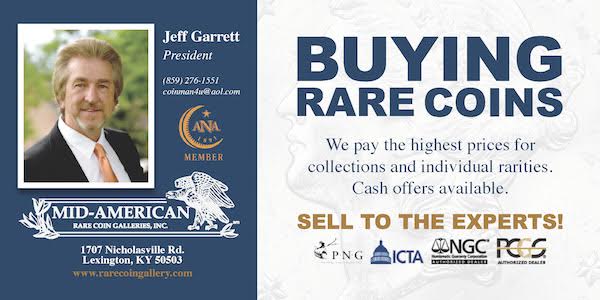
CSNS CONVENTION HOTEL ALMOST SOLD OUT
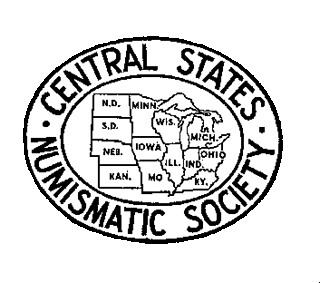 The Schaumburg Renaissance Hotel, host lodging facility for the 79th Anniversary Convention of the Central States Numismatic Society, is on the verge of being sold out over two of the event
nights, according to Patricia Foley, CSNS Secretary and Bourse Chairman for the 300+ booth event.
The Schaumburg Renaissance Hotel, host lodging facility for the 79th Anniversary Convention of the Central States Numismatic Society, is on the verge of being sold out over two of the event
nights, according to Patricia Foley, CSNS Secretary and Bourse Chairman for the 300+ booth event.
Booth holder move in, the Early Bird period and opening of public hours will be on Wednesday, April 25. Public hours will continue Thursday through Saturday, concluding on April 28. Heritage Signature Sales for both rare coins and currency will take place Wednesday through Friday.
Foley said of lodging availability, “The Renaissance Schaumburg is a very popular venue for corporate meetings and we will not be the only event in the hotel and convention center over our dates. Thursday and Friday already have just a handful of rooms still available and Wednesday is not far behind. Especially because we offer our booth holders a $175 rebate for stays of three or more nights under our room block at our $159 rate, I want to make certain that everyone is aware of the tight lodging situation we’ll be facing this year. I hope that everyone will call the hotel ASAP if they haven’t already. Once the hotel is sold out, it will be sold out and there will be little we can do to help.”
To reserve a sleeping room, call the Schaumburg Renaissance at (847) 303-4100 and mention “Central States Numismatic 2019” for the discounted $159 event rate.
VOCABULARY TERMS: DIE CAVITY, HIGH POINT
Two related terms are discussed this week. Die cavity is a term used by die makers, it creates the high point, a term used by inspectors, collectors and numismatists.
Die Cavity. The vacant space in a die that is the design. The low point of the die cavity would be the HIGH POINT on the item struck from that die. Creating this
negative area is what is required in HAND ENGRAVING by carving; for mechanically prepared dies the die cavity is what is cut away on the die-engraving PANTOGRAPH, or a milling machine for computer
engraving. Or the die cavity can be created by pressing the master die into a die blank during HUBBING. The die cavity contains the MODULATED RELIEF of the design but in the negative, of course.
Usually the die with the greatest cavity is placed in the lower (PILE) position in the press when MULTIPLE STRIKING is performed; this aids in positioning the medal by hand each time it is placed in
the press to be struck. See DIES AND DIEMAKING.
CLASS 04.1
High Point. The point of highest relief on a numismatic or medallic item. The high point – often the nose on a portrait – is formed from the lowest point of the die cavity. Examining the high point in the press room during striking is necessary for both medals and coins; it is the critical point which determines whether a medal is fully struck up in multiple striking, or for a coin during SET UP. High points are examined in the finishing department for medals, which are oxidized and relieved. They are examined to insure the high point is not overly buffed.
High points are the first to wear and the most vulnerable to damage, thus they are an important factor of CONDITION. A collector or numismatist will check first an item’s high points to determine wear or condition. If high points are particularly worn they are sometimes designated CONTACT MARKS.
Also there are special high points – called SUPPORT POINTS. These are usually three in number, usually located on the reverse and sometimes hidden in the design purposely by the designer or
modeller Support points, as expected, support the item as it rests on a flat surface, the intent is to prevents wear to the remainder of the design.
CLASS 03.4
Looking for the meaning of a numismatic word, or the description of a term? Try the Newman Numismatic Portal's Numismatic Dictionary at: https://nnp.wustl.edu/library/dictionary

STANISLAUS VINCENT HENKELS (1854-1926)
 Stanislaus Vincent Henkels (1854-1926), was born at Philadelphia, Pennsylvania, on February 8, 1854, the son of native Philadelphians, George Jacob Henkels (1819-1883), a cabinet maker, and
Elizabeth Regina Snyder Henkels (1821-1881).
Stanislaus Vincent Henkels (1854-1926), was born at Philadelphia, Pennsylvania, on February 8, 1854, the son of native Philadelphians, George Jacob Henkels (1819-1883), a cabinet maker, and
Elizabeth Regina Snyder Henkels (1821-1881).
Stan V. Henkels is one of the outstanding Philadelphia numismatists and antiquarians in American history. He worked as an auctioneer, bookseller, cataloguer, and a leading authority on autographs, rare books, prints, and Washingtoniana. In his career as an auctioneer he conducted at least 14 coin auction sales.
In the 1880 U. S. Census he is living with his parents in their home at Philadelphia and working as an auctioneer, where he worked for the old firm Thomas Birch's Sons on Chestnut Street.
From 1882-1883 he was the senior partner in Henkels & Tripple, 1117 Chestnut Street, Philadelphia.
On November 27, 1882, John White Haseltine catalogued the A. M. Smith collection of 1,930 lots and Stan. V. Henkels conducted the auction at Henkels & Tripple.
In 1883, he married Martha Magdalene Duke (1856-1950). They had seven children : Martha Magdalene (1884-1975), Mary Elizabeth (1886-1961), Stanislaus Vincent, Jr. (1889-1943), Elizabeth Regina (1891-), Duke Howard (1894-1973), William King (1897-), James Mitchell (1900-1907).
From 1883-1886 he was the proprietor of Stan. V. Henkels & Co., 1117 Chestnut Street, Philadelphia.
From 1890-1897, he was chief auctioneer for Thomas Birch's Sons, 1110 Chestnut Street, Philadelphia. During this period his name was published as cataloger.
On November 10, 1890, Henkels catalogued The Final Settlement of the Estate of General George Washington, by the order executor of Lorenzo Lewis, Executor for the Estate of Lawrence Lewis, Late Executor of the Estate of Gen. Geo. Washington. This sale was held six months prior to the famous Unveiling Ceremony of the Washington Monument at Fairmount Park, Philadelphia on May 15, 1891. Surrounding that famous ceremony was an era of interest and nostalgia in America's past and a new wave of patriotism sparked.
He died on April 23, 1926, at Philadelphia, Pennsylvania.
After his death the firm Stan. V. Henkels was relocated at 1110-1116 Sansom Street, Philadelphia.
To read the complete article, see:
HENKELS, STANISLAUS VINCENT
(https://sites.google.com/a/numismaticmall.com/www/numismaticmall-com/henkels-stanislaus-vincent)
The entire inventory of the Lupia Numismatic Library is for sale. Individual items will be available before the remaining archives are broken up into parcels sold at philatelic auctions in the U. S. and Hong Kong. Check NumismaticMall.com frequently as dozens of new items with estimates will be posted daily until everything is sold.
All inquiries will be given prompt and courteous attention. Write to: john@numismaticmall.com .
HARVEY STACK'S NUMISMATIC FAMILY, PARTS 10-11
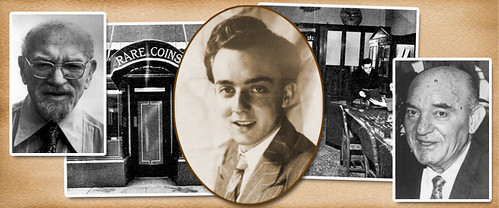
In mid 1950 Norman, who was working very closely with my father, was drafted into the Army because of the nation’s involvement in the Korea War. As both Ben and I were married at the time, we were exempt from the first draft, which took only single men. Norman had to report for service by December 1950.
That same year, Ben went to his father, Joseph, and insisted that since he was the oldest of the juniors, he should be made a partner. This wounded my Uncle Joe, especially as Norman had been drafted and went into the service. They fought about it, with Joe saying he was considering giving both Ben and Norman a partnership when Norman returned from the Army. The debate got very intense, and Ben shouted at his father and stormed out of the shop. A few months later Ben moved with his family to Las Vegas to open up a coin shop there. He wanted to open his store in Vegas, because it was a growing city, with lots of money being spent and gambled, and he felt he could do well out there. (More about Ben’s future in numismatics will be told later.)
During the same time frame, my father, Morton, fell and broke his upper arm. The break was so bad that they had to use "pins" to set it. Unfortunately the break became infected and Morton developed a form of osteomylitis that required treatment and medication three times a day. A private nurse visited him three times each day; she would remove the old bandages, clean the wound, and redress it. This was another great loss to the operation at Stack’s.
But Stack’s had not only my Uncle Joe and a dedicated staff, but also many collector and dealer friends who would come in to help out, by sorting coins, doing attributions and just being helpful. To mention a few, there was William Blaisdell, Ray Gallo, Doug Smith, Harold Bareford, Joseph Spray, Fred Knobloch, Oscar Schilke, Martin Kortjohn, and Ed Rice. Each would stop into the shop, spend a few hours and be of great help. That was the relationship the Stack family had with collectors.
Fortunately we were able to hire John Burnham (who later became curator of the Yale University coin collection) who was proficient in coins of the United States, federal as well as colonial, and also the currency of the period. We also re-engaged Hans Holzer, a European expert.
During this hectic period, we all worked very long days and on weekends when necessary, but we managed to get the work done. We still maintained the schedule we had established before our difficulties arose. I still was in charge of the shop, and I also stocked, cataloged and worked with all to maintain the pace. It wasn't easy, but it had to be done.
By early spring 1951, Morton had overcome the infection in his arm, and once again came to work daily to shoulder his responsibilities in the office.
As I wrote in an earlier series of articles, we were lucky to open a new account with Josiah K. Lilly, chairman, Eli Lilly & Co. the famous pharmacy house in Indianapolis, Indiana. It was early spring in 1951 when a well-dressed gentleman walked into our shop, looked about, and asked my father (at the counter) if we had any Spanish Colonial Doubloons in stock. He said that he had a great fondness for the sea and had spent much time reading the early history of the Spanish who came to Central and South America in the early 16th century through the 18th century. He wanted to own a "piece of gold" of the period.
Morton said he had a number of different specimens in stock, and explained to Mr. Lilly that several of the Spanish American colonies (later countries), issued coins during the colonial period, as this was a way to ship the gold they plundered from the natives of Central and South America.
Morton first showed Mr. Lilly a Portrait piece and a Cob, each denominated as 8 Escudos. He also explained that the Spanish American mints made smaller denomination in gold, such as the 4 Escudos, 2 Escudos and even 1 Escudo. Mr. Lilly was fascinated by these facts and decided to try to build a collection, From the assortment he was shown he selected 12 different representative examples. Mr. Lilly wrote a check and requested that once it cleared we send the gold coins on to him at his office. During the visit, my father introduced Mr. Lilly to Uncle Joe, and also wanted me to meet him, so I could help him in the future should he decide to continue building his collection.
Before Mr. Lilly left, we gave him a copy of Wayte Raymond's book called, "Central and South American Spanish Colonial Gold." It contained a listing of each country, mint and denomination. It did not discuss rarity, but provided a checklist that a serious collector could use to determine what was known about the series, up to the date of publication of the book.
To read the complete articles, see:
Growing up in a Numismatic Family Part 10 (http://www.stacksbowers.com/News/Pages/Blogs.aspx?ArticleID=2826)
Harvey Stack Remembers: Growing up in a Numismatic Family, Part 11
(http://www.stacksbowers.com/News/Pages/Blogs.aspx?ArticleID=2844)
To read the earlier E-Sylum article, see:
HARVEY STACK'S NUMISMATIC FAMILY, PART 9 (http://www.coinbooks.org/v21/esylum_v21n02a19.html)

TREASURY LAW ENFORCEMENT ON STRANGE INHERITANCE
From an email to THA members:
Featured in the aired presentation is special agent Mike Malone, uncle of THA member Martin I. Dolan III, MD. We thought that many THA members would be interested in viewing this episode of the "Strange Inheritance" show on the Fox Business Channel, as it provides a historic background of Treasury's law enforcement missions.
The Treasury Historical Association has endorsed and is assisting Dr. Dolan in his efforts to research the history of his uncle's work for the Treasury Department and and that of other agents. These efforts are helping to gain national recognition of the accomplishments of Treasury's founding director of the Criminal Investigations Division (a.k.a. Intelligence Division), Elmer Irey, and a few of his agents, one of whom is Mike Malone.
We are hopeful that the contributions of these Treasury agents (known as "T-Men" back in those days) might be recognized by nomination for the Presidential Medal of Freedom, which THA fully supports, and potentially other types of recognition, such as this forthcoming television episode and various media exposure opportunities. This team of Treasury agents brought to justice such infamous individuals as Al Capone and solved the Charles Lindbergh baby kidnapping case, and completed many other investigative cases that helped bring to justice many criminals who threatened the public safety in those tumultuous days.
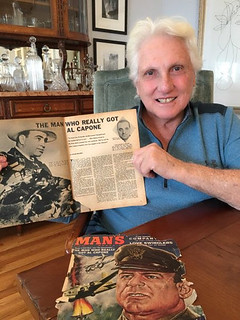 A nephew inherits boxes of original IRS documents revealing his uncle was one of four undercover agents who helped take down Al Capone and solve the Lindbergh Baby kidnapping.
A nephew inherits boxes of original IRS documents revealing his uncle was one of four undercover agents who helped take down Al Capone and solve the Lindbergh Baby kidnapping.
Previously unknown details about historic criminal cases -- including the Lindbergh kidnapping and the infiltration of the Al Capone gang -- are revealed in thousands of pages of investigative files found in the crawlspace of a New Jersey home.
The original documents were inherited by Laguna Beach physician Marty Dolan, who tells his family’s story on the latest Strange Inheritance with Jamie Colby. The episode premieres Monday, Feb. 12, at 9 p.m. ET on the FOX Business Network.
Dolan thought the files just contained boring audit reports. Then he noticed one titled, “Regarding Alphonse Capone,” and another, “Kidnapping and Murder of Charles Augustus Lindbergh Jr.”
Pre-Google, Dolan found it impossible to dig up details about mysterious Uncle Mike. Even a private detective didn’t help. Since then, Dolan has been working to correct the Hollywood version of who actually took down Al Capone. Based on the evidence Dolan has, it clearly wasn't Elliot Ness. Watch Monday's program to find out more.
David adds:
The Lindbergh kidnapping story will be interesting. I recall that some of the ransom money was recovered and was in $10.00 Gold notes.
For more information, or watch a preview, see:
Strange Inheritance: Mob files revealed (http://video.foxbusiness.com/v/5728297375001/?#sp=show-clips)
WHAT HAVE YOU FOUND IN OLD BOOKS?
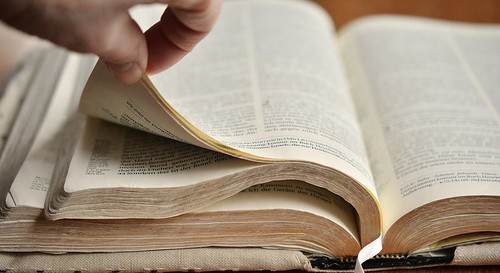
WHEN LORRAINE SMITH FOUND A mysterious manuscript in a used copy of Alice in Wonderland, her discovery sent her on a hunt to uncover the document’s origins. She’d owned and operated a used book shop for 17 years, and never before had one of her titles contained anything like this piece of parchment from 1583.
After we published Smith’s story, Atlas Obscura readers started sharing unexpected discoveries inside used books that they’d made themselves. One reader found a soldier’s records from the Boer War inside a volume of Alexander Pope’s collected letters. Another reported finding a 20-year-old email, printed out, that one of the book’s authors had sent to the other. One reader even found “a small slip of paper,” which turned out to be “a receipt for the purchase of milk from Offin Boardman—dated April 4, 1776.”
We love these stories, and want to hear more. Please tell us: What’s the best or most unexpected treasure you’ve ever discovered hiding in a book?
To read the complete article, see:
Tell Us About the Most Amazing Things You’ve Found in Old Books
(https://www.atlasobscura.com/articles/things-found-in-used-books)
[Saint-Gaudens’ son Homer was associated with the Carnegie Museum in Pittsburgh. I recall a story told by Glenn Mooney, one of the local volunteer curators who worked alongside head curator W.W. Woodside. Glenn said that Homer had arranged to donate an extremely high relief double eagle to the Museum’s collection. For a time the coin was misplaced and no one could locate it. Eventually it turned up in the reference library – someone (probably Woodside himself) had accidentally closed a reference book with the coin inside. It was an embarrassing lapse, but everyone got a chuckle out of it at Woodside’s expense. I assume this coin was part of the holdings sold when the Museum dispersed the bulk of the collection in the late 70s/early 80s. With these coins selling now in the multi-millions, it would have made for an interesting find in the stacks of the library (the coin department’s reference library was transferred to the Carnegie Library of Pittsburgh in the early 80s). -Editor]
To read the earlier E-Sylum articles, see:
GEORGE KUNZ AND THE EXTRA HIGH RELIEFS (http://www.coinbooks.org/esylum_v08n49a12.html)
HOMER SAINT-GAUDENS AND THE CARNEGIE HIGH RELIEF $20 (http://www.coinbooks.org/esylum_v08n50a17.html)

FRED HOLABIRD'S TUCSON GOLD RUSH EXHIBIT
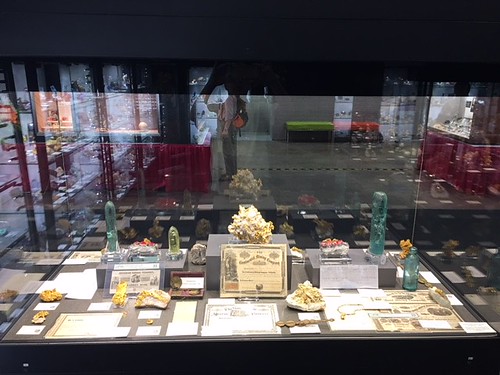
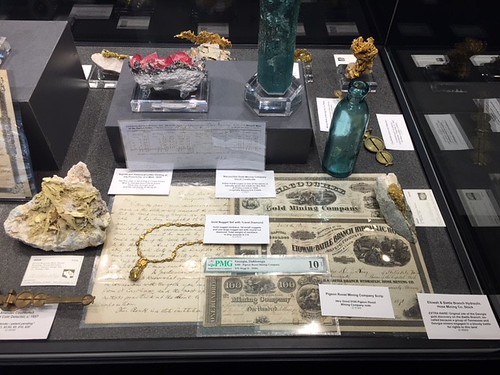
For mroe information on Fred's upcoming sale, see:
http://holabirdamericana.com/
ARCHIVES INTERNATIONAL SALE 47
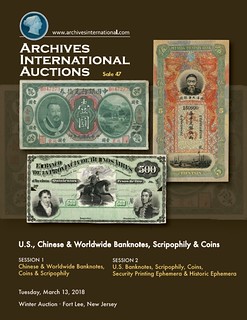 On behalf of the entire Archives International Auctions team, I would like to personally welcome you to our 47th auction we have held over the last ten years. We are excited to offer over
950 lots of rare and desirable U.S. & Worldwide Banknotes, Scripophily and Coins in our first auction of 2018.
On behalf of the entire Archives International Auctions team, I would like to personally welcome you to our 47th auction we have held over the last ten years. We are excited to offer over
950 lots of rare and desirable U.S. & Worldwide Banknotes, Scripophily and Coins in our first auction of 2018.
Included in the sale are consignments from numerous estates and longtime collections with many items having never been offered previously at auction. Included in the sale is a desirable selection of U.S., Chinese and Worldwide Banknotes, Scripophily, Coins, and Security Printing Ephemera.
We are offering over 130 lots of Chinese Banknotes and Scripophily. Some of the highlights of the Chinese section include a 1912, Bank of China “Peking” Branch issue rarity, possibly the finest known; 4 attractive examples of the Kiangse Government Bank, 1907 Dollar Issue; and an outstanding Peiyang Tientsin Bank, ND (ca.1910) 5 Tael Issue and dozens of other rare and desirable notes. Chile is highlighted by 2 Specimen examples of the extremely rare bank, Banco Agricola, ca.1870, 1 and 5 Pesos notes that are only known in Proof form with no issued examples known and is unpriced in the SCWPM; A very attractive offering of 30 different Colombia Proof banknotes, ca.1886 to 1951, are offered, most in Gem Uncirculated condition; a lovely 1905 Danish West Indies, 10 Francs face proof is offered and the French banknote offering includes an exceptional assortment of Siege Notes.
An exceptional offering of Iran, Bank Markazi specimens, ca.1971 to 1982 issues, of over 30 different varieties, many unlisted in Specimen format will highlight the sale. Hundreds of additional worldwide notes are sure to attract attention of the beginning to serious collector as well as dealers with many single notes to large group lots that are fresh to the marketplace and have never been offered in auction previously. Another major highlight of the auction is a presentation specimen booklet of the 1982 to 1989, U.A.E. Currency Board set of 6 different Specimen notes from BW&C, many in choice to Gem condition and rare in this format. Philippines includes an exceptional aBangko Sentral ng Philippines, 1998 Commemorative 100,000 Piso Banknote as well as numerous early issues. The first session ends with 45 lots of Ancient and World Coins with many desirable coins included.
The second session includes U.S. coins, Banknotes, Scripophily and Security Printing Ephemera. Highlights include many proof obsolete notes from the Silver City Collection we offered in 2010-2011 with many rare notes never seen before that sale. The Scripophily section is highlighted by an Alaska Gold and Silver Mining Company, 1878 Stock Certificate, issued only 12 years after Seward’s Folly of his purchasing Alaska from the Russians in 1867; an extremely early and rare 1904 Ford Motor Company of Canada is offered as well as over 110 lots of issued and specimen railroad stocks and bonds; the Scripophily section includes over 350 lots of rare and interesting bonds and shares with numerous topics that are represented.
We are now working on our Winter and Spring 2018 auctions and are seeking consignments for our upcoming sales. Please contact us to discuss how you may participate in our future auctions. I would like to thank everyone who has participated in our previous sales and has helped make this auction series a resounding success. We are looking forward to another exciting auction and hope you enjoy our current offerings.
For more information, see:
http://www.archivesinternational.com/
THE BOOK BAZARRE
NUMISMATIC NUGGETS: FEBRUARY 11, 2018
Kentucky Cent
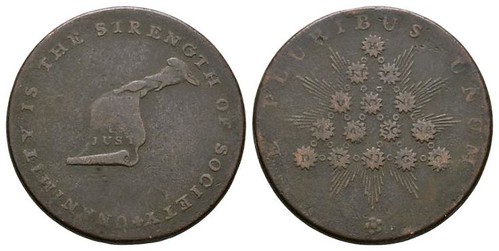
Description: Struck circa 1793 AD. Obv: hand holding inscribed scroll with UNANIMITY IS THE STRENGTH OF SOCIETY legend. Rev: pyramid of stars with initials of the first fifteen states with rays behind and E PLURIBUS UNUM legend. Edge: plain. KM# Tn70.1.9.80 grams.
To read the complete lot description, see:
Lot 3453: World Coins - USA - Kentucky - Token Cent (https://www.invaluable.com/auction-lot/-1-c-29F47319A1)
1846 Free Trade Anti-Corn Law League Medal


Description: One 1846 Free Trade Anti-Corn Law League Medal.
To read the complete lot description, see:
Lot 611: 1846 Free Trade Anti-Corn Law League Medal (https://www.invaluable.com/auction-lot/-1-c-8DC4601B83)
For more information on the Corn Laws, see:
Cobden and the Anti-Corn Law League (http://oll.libertyfund.org/pages/cobden-and-the-anti-corn-law-league)
Anti-Corn Law League (https://en.wikipedia.org/wiki/Anti-Corn_Law_League)
1856 Convict Cross Token
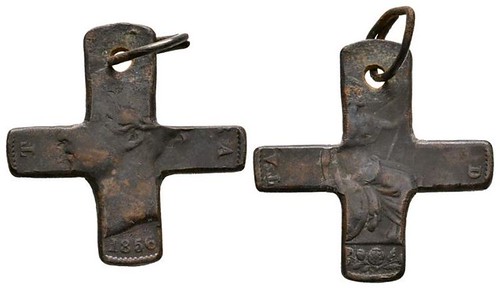
Description: 19th century AD. Coin dated 1856 (Victoria copper halfpenny), pierced for suspension with wire loop; the coin cut into an equal armed cross pendant. See S. 3949 for coin.4.69 grams.
To read the complete lot description, see:
Lot 3562: Victoria - 1856 - Convict Cross Token (https://www.invaluable.com/auction-lot/-1-c-0DF4EFEB7F)
Hackney Horse Society Gold Medal
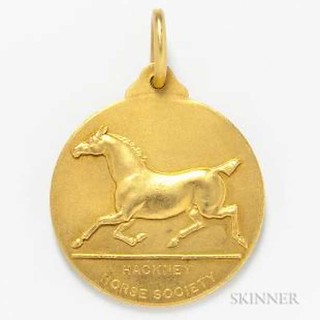
Mappin & Webb Hackney Horse Society Gold Medal, 68.35 grams.
It always makes for a striking medal
-Editor
To read the complete lot description, see:
Auction Preview: Coins & Currency Online at Skinner, Marlborough, Feb 8 -16
(http://www.blouinartinfo.com/photo-galleries/coins-currency-online-8-16-at-skinner-marlborough-feb-8?image=7)
Oberwise Liberty Quarter Premium Album
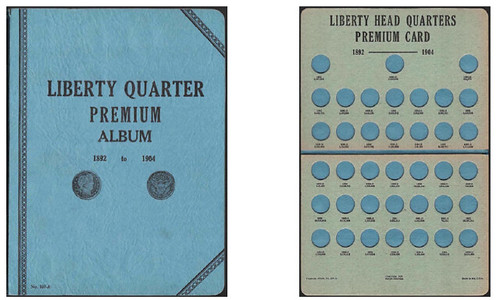
LIBERTY QUARTER PREMIUM ALBUM 1892 to 1904 O106 107-A VF-NM $28 Looks NM overall, but has a very small tear at top of spine; extremely rare title, especially so nice

MARK ANTONY’S LEGIONARY DENARIUS
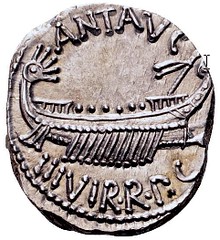
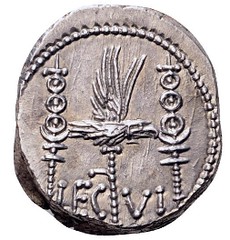
Mark Antony (or Marcus Antonius) played a key role in the civil wars that led to the end of the Republic and the beginning of the Empire – a period numismatists often describe as the “Imperatorial” era. The Latin word imperator at this time meant “commander” or “warlord” rather than “ruler”.
Roman coinage in the name of Marcus Antonius extends from 44 to 31 BCE and the so-called legionary denarii issued in 32-31 BCE to pay his army are, by far, the most abundant Roman silver coins. The best estimate is that between 25 million and 35 million pieces were struck (Harl, 60), and tens of thousands survive today.
The coin’s obverse shows a galley, sometimes described as Antony’s flagship. The ship has a single bank of eight to 12 oars (the number of oars was probably left to the whim or patience of the die cutter). Above the ship ANT AVG abbreviates the name Antonius along with one of his titles, Augur, a priest of the Roman state religion.
The reverse shows a legionary eagle (aquila) between two standards (signa; singular signum), with an inscription identifying one of the units in Antony’s army.
To read the complete article, see:
CoinWeek Ancient Coin Series – Mark Antony’s Legionary Denarius
(https://coinweek.com/ancient-coins/coinweek-ancient-coin-series-mark-antonys-legionary-denarius/)
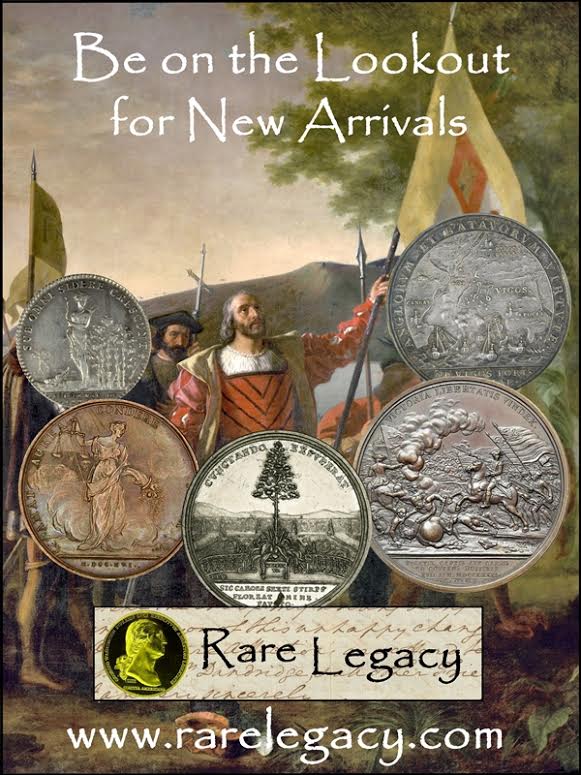
MUSLIM COIN FEATURES MENORAH SYMBOL
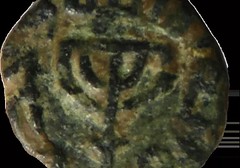 Researchers recently discovered that menorahs prominently adorned Muslim coins and vessels during the early Islamic period 1,300 years ago.
Researchers recently discovered that menorahs prominently adorned Muslim coins and vessels during the early Islamic period 1,300 years ago.
Last year, archeologists Assaf Avraham of Bar-Ilan University, and Peretz Reuven of the Hebrew University of Jerusalem exposed an early Islamic inscription referring to the Dome of the Rock as “Beit al-Maqdis.”
According to scholars, the “Nuba inscription,” as it is called, implies that in the early days of Islam, Muslims perceived the shrine as an Islamic version of the Temple of Solomon.
Now, researchers are exposing further finds in Israel that constitute evidence of Jewish influences in the early days of Islam.
“The Jewish symbol which the Muslims were using was the menorah [the gold seven-branch candelabra from the Temple], which appeared on several coins and other early Islamic artifacts,” said Avraham on Wednesday.
“The menorah coins bear the Shahada Arabic inscription on one side: ‘There is no god but Allah,’ while the menorah appears in the center of the coin. The other side bears the inscription: ‘Muhammad [is the] messenger of God.’”
In addition to the coins, the archeologists are presenting several pottery and lead vessels from the early Islamic period that also utilized the menorah symbol in their design.
“They are dated to the early days of the Islamic caliphate, and were in use by Muslims,” said Avraham, noting that the finds are of great importance for understanding the history of Islam.
To read the complete article, see:
ARCHEOLOGISTS DISCOVER MENORAH INSCRIBED ON EARLY ISLAMIC PERIOD COINS
(http://www.jpost.com/Israel-News/Archeologists-discover-menorah-inscribed-on-Early-Islamic-period-coins-517190)
ARCHEOLOGY AS A POLITICAL WEAPON
Emek Shaveh’s Mizrachi: When you control the past, you control the present and the future.
 In Israel, archeology is far more than just science.
In Israel, archeology is far more than just science.
Indeed, perhaps more than any other country, the stakes of antiquities unearthed here could not be higher in terms of geopolitical implications used by warring factions to determine “facts on the ground” in the most contested region in the world.
The battle between right- and left-wing ideologues is evident at archeological sites in east Jerusalem and the West Bank, where discoveries are routinely exhibited to the world as evidence of Israeli sovereignty in the Jewish homeland or as an occupier.
The two main opponents in the ongoing war over rightful sovereignty between Jews and Palestinians are the left-wing archeological political activist NGO Emek Shaveh, and its right-wing counterpart, the City of David Foundation (also known as Elad).
The former is primarily funded by European countries with a decidedly “anti-occupation” stance, while the latter deems the term “occupation” an incendiary insult to a people with thousands of years of history in Jerusalem.
Last week, the heads of Emek Shaveh and the City of David Foundation explained why they allege the other is attempting to manipulate history to further their respective political narratives at the expense of science
To read the complete article, see:
ARCHEOLOGY IN ISRAEL AS A POLITICAL WEAPON
(http://www.jpost.com/Israel-News/Archeology-in-Israel-as-a-political-weapon-515922)

MORE IMAGES OF ISIS COINAGE?


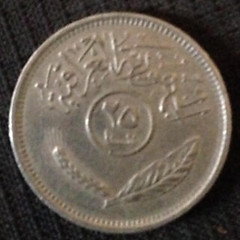

NOTE: it has since been determined that the second pictured coin is actually an Iraqi Republic 25 fils piece.
To read the earlier E-Sylum articles, see:
QUERY: WERE THESE COINS MADE BY ISIS? (http://www.coinbooks.org/v21/esylum_v21n01a32.html)
ANSWER: WERE THESE COINS MADE BY ISIS? (http://www.coinbooks.org/v21/esylum_v21n02a11.html)
NEW IMAGES OF ISIS COINAGE (http://www.coinbooks.org/v21/esylum_v21n05a24.html)
HAS THE UNFAKABLE POUND COIN BEEN FAKED?
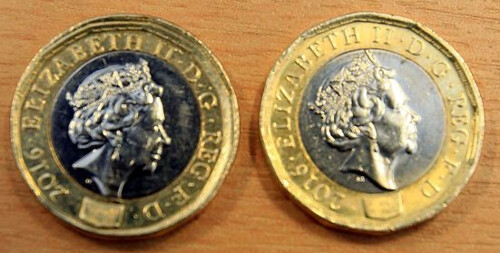
Martin Shaw from Huddersfield says the coin is odd in almost every way but he isn't convinced it is a fake
The 12-sided coin, dated 2016, was found in Huddersfield, West Yorkshire, and at first glance appears different to other recently minted change.
From the side it looks like two coins melted together while the Queen's neck protrudes at the bottom and her head is misaligned, as is the wording around the edge.
Its new owner, Martin Shaw, said: "It just didn’t feel right and it was certainly different to the other pound coins. My first thought was it was a fake."
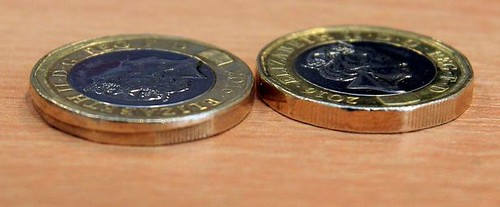
The Royal Mint has previously said new quids are 'unfakeable' and if confirmed it is believed this would be the first in existence.
The square holograms on the bottom of the new pound are supposedly impossible to counterfeit.
They show a £ symbol if turned one way and the number 1 if turned the other but Mr Shaw said while a slightly less pronounced square was there and he could make out a faint '1' he could not see a '£' at all.
"The Royal Mint says no fake has ever been confirmed but there are coins with 'production errors' in circulation.
"It says with coins produced in such volumes mistakes are bound to occur occasionally."
To read the complete article, see:
Is this the first fake new £1 coin? Odd quid has dodgy hologram, wonky Queen and misaligned wording
(https://www.mirror.co.uk/news/uk-news/first-fake-new-1-coin-12006665)

1904 ST. LOUIS OLYMPIC PARTICIPATION MEDAL
Henry Warshaw has been a coin collector since he was a child.
“When you're eight or nine or 10, it usually starts with pennies, and nickels and dimes,” Warshaw said.
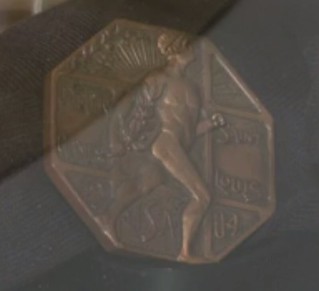 Decades later, when he saw a rare item come up for auction, he realized he had to purchase it. It is a participation medal from the 1904 Olympics, which were held in St. Louis.
Decades later, when he saw a rare item come up for auction, he realized he had to purchase it. It is a participation medal from the 1904 Olympics, which were held in St. Louis.
He donated it to Washington University, his alma mater. It will be displayed with other St. Louis Olympic memorabilia.
“It's way more important to be displayed in public than being in a bank vault somewhere,” Warshaw said.
The 1904 games were the first ones during which athletes received gold, silver or bronze medals. They also received the participation medals
“It was the beginning of the Olympics in this country,” said Warshaw. “These coins, these medals, tell a history. They all have stories with it.”
The rare medal is worth an estimated $20,000.
To read the complete article, see:
Collector shares piece of STL Olympic history
(ksdk.com/article/news/local/collector-shares-piece-of-stl-olympic-history/63-515021878)
THE 2018 WINTER OLYMPIC MEDALS
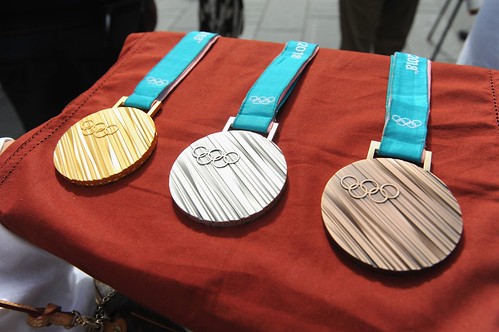
Each Olympics introduces a new set of medals that athletes have spent their lifetime chasing. This year, the PyeongChang Olympics are featuring prizes loaded with Korean culture and tradition. And more silver than you might think, at least when it comes to the top prize.
This Olympiad’s medals were designed by South Korea’s Lee Suk-woo, with a diagonally striated design on the front inspired by the texture of tree trunks. The front also features the Olympic rings, while the back states the sport, event and PyeongChang 2018 emblem. Along the sides, “Olympic Winter Games PyeongChang 2018” is spelled out in Hangul, the Korean alphabet.
As far as what makes up the medals, don’t go thinking the gold medal winners are getting pure gold, which hasn’t happened since the 1912 Stockholm Olympics. Like past medals, the gold medals for this Olympics are mostly composed of silver, using 580 grams with a 6-gram gold coating. In total, the 259 gold medals handed out in PyeongChang will hold 1,554 grams of gold, or 3.43 pounds.
Using only a thin layer of gold, while possibly disappointing for the purists, makes sense when you remember gold is extraordinarily expensive and only getting more expensive. Currently trading at around $1,330 per ounce, the gold in Korea’s gold medals would trade at around $281 per medal and $72,905 total. You can only imagine how expensive medals would if they were made with, say, 600 grams rather than six.
The silver medals are essentially the gold medals without the gold, composed of 580 grams of silver. Between the gold and silver medals, this Olympics’ medals will use 300,440 grams of silver, equivalent to 662 pounds or nearly a third of a ton. With silver hovering around $17 per ounce, that chunk of silver would go for around $180,000 between the two sets of medals.
The medals get a bit less lavish when you reach third place, as the bronze medals will be composed of 493 grams of simple copper.
To read the complete article, see:
Here's how much gold is actually in the PyeongChang Olympics' medals
(https://sports.yahoo.com/heres-much-gold-actually-pyeongchang-olympics-medals-011226697.html)
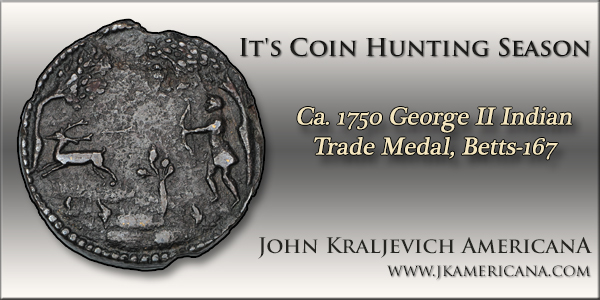
UKRAINE'S 2018 WINTER OLYMPICS HOLOGRAPHIC COIN
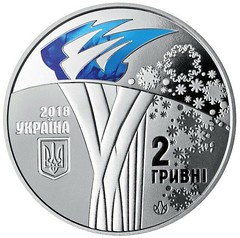
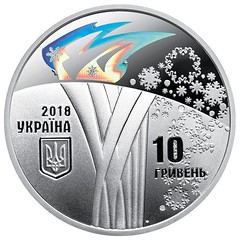
The National Bank of Ukraine have issued (11th January) two new coin denominations which were minted in support of the Ukrainian Winter Olympics team who are on their way to the XXIII Winter Olympiad, set to be hosted by the city of PyeongChang, South Korea. The first Ukrainian Winter Olympics team participated as an independent nation in the 1994 Games which were hosted in Lillehammer, Norway, and have participated in every Winter Olympiad since.
The coins are minted in silver and cupro-nickel and were produced by the Mint of Ukraine on behalf of the National Bank of Ukraine. The obverse side of the coins was designed by Volodymyr Taran, Alexander Kharu, and Sergey Haruk and includes a stylised torch in the form of the Roman numeral “XXI??.” They also feature a holographic image on the silver coins and a colourised flame on the base metal version. The flame is one of the symbols of the Olympic Games. On the left of the primary design is the small state emblem of Ukraine, above which is the inscription, ???????, and the year of issue of the coin, 2018. On the right side is a collection of stylised snowflakes and the face value of 2 or 10, for the cupro-nickel and silver issues, respectively.
To read the complete article, see:
Ukraine: Winter Olympiad celebrated with new silver holographic crown coin
(http://news.coinupdate.com/ukraine-winter-olympiad-celebrated-with-new-silver-holographic-crown-coin/)
1912 WOMEN'S HUNGER STRIKE MEDAL
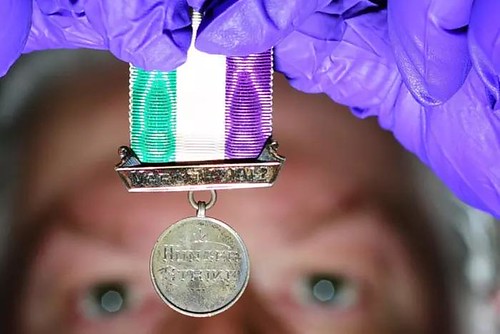
The battle for women’s suffrage was long, hard-fought and at times bitter, and the acclaimed Brotherton Library at the University of Leeds is home to several historic items that help relay the story of this struggle. They include a magazine called Votes For Women, issued by the Women’s Social and Political Union, and a rare medal dating back to 1912, presented to a suffragette called Alice Davies for taking part in a hunger strike in protest against the treatment of women.
There is also an original women’s voting registration form relating to the 1918 General Election.
Richard High, Collections Engagement Librarian at Leeds University Library, says it’s an important document. “It was such a significant moment for women and this is the most interesting item for me because it is the real thing, it’s what somebody, we don’t know who for sure, would have been sent and had in their possession,” he says.
“We see today from different places in the world where countries are opening up to democracy and people can vote for the first time, just how enthusiastic they are with long queues at polling stations, and it must have been the same a hundred years ago in this country when women were taking part and voting for the very first time.”
The medal was issued to women who’d been arrested during various demonstrations and who then took part in a hunger strike,” says High.
It was awarded by the Women’s Social and Political Union (WSPU), the leading militant organisation campaigning for Women’s suffrage at the time, and is tied to a green, white and purple ribbon (representing hope, purity and dignity), which were the colours of the organisation.
To read the complete article, see:
Historic items in Leeds that chart the struggle for women’s
votes in 1918. (https://www.yorkshirepost.co.uk/news/analysis/historic-items-in-leeds-that-chart-the-struggle-for-women-s-votes-in-1918-1-9003599)
VIDEO: STRIKING THE WOMEN'S SUFFRAGE 50 PENCE

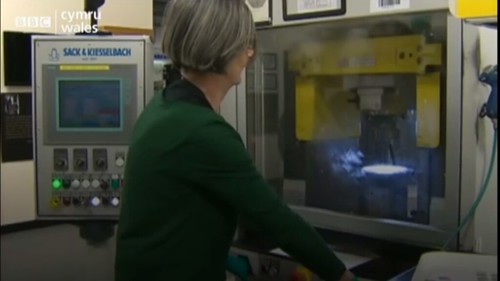

To watch the complete video, see:
Emmeline Pankhurst's great-granddaughter strikes memorial 50p (http://www.bbc.co.uk/news/uk-wales-42922156)
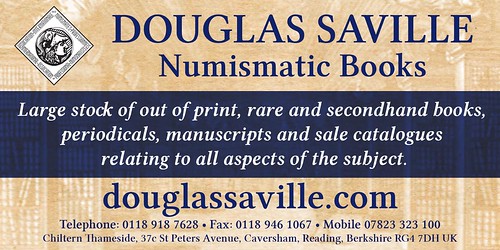
HISTORIC BANK OF ENGLAND PAPER MILL DESTROYED
 17th century mill once used to make paper for some of the first British banknotes has been destroyed by fire.
17th century mill once used to make paper for some of the first British banknotes has been destroyed by fire.
Dozens of firefighters battled to save Bere Mill, in Whitchurch, Hampshire, after the blaze broke out on Wednesday night.
The Saxon building, which was previously used to supply the Bank of England, was badly damaged.
Hampshire Fire and Rescue Service said more than 50 firefighters in 12 engines had fought to save parts of the historic property.
The building was the original paper mill for Portals, the company that first supplied notes to the Bank of England in 1718.
The Bank of England has been issuing banknotes since 1694.
Over the years, the gardens of Bere Mill have been opened up as part of the National Garden Scheme.
The scheme's website says: "The mill buildings were the original location of Portals who first sold bank note paper to the Bank of England from the mill.
To read the complete article, see:
Whitchurch fire: Historic mill that made paper for early British banknotes is
destroyed in blaze (http://www.telegraph.co.uk/news/2018/02/08/whitchurch-fire-historic-mill-made-paper-early-british-banknotes/)
NIGERIAN ARTIST DRAWS BANKNOTES
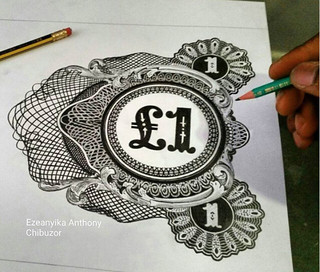 It's now been a decade since the old Maltese Lira gave way to the Euro, and stumbling upon old currency keeps getting rarer. Some people might have even forgotten what the old banknotes
look like, but if that's the case, one Nigerian artist has made it way easier to go back in time.
It's now been a decade since the old Maltese Lira gave way to the Euro, and stumbling upon old currency keeps getting rarer. Some people might have even forgotten what the old banknotes
look like, but if that's the case, one Nigerian artist has made it way easier to go back in time.
Ezeanyika Anthony Chibuzor is a pencil artist who recreates photos to the most minute details. A couple of years ago, he embarked on an ambitious project like no other; drawing all the world's banknotes with two pencils. He's been sharing hundreds of photos of his work on Instagram since 2014, and eventually, he's made it to the Maltese Lira.

Choosing the Lm20 note, Anthony first shared a photo of the note in the process of being drawn a couple of days before the final product. Eventually, the complete banknote was also shared, and it definitely didn't disappoint. The attention to detail, as expected, is something out of this world.
So far, Anthony has drawn up to 170 different banknotes from around the world.
"The Global Currency Project is designed to acknowledge all the currency notes in the world through pencil drawing," he said in an Instagram post. "This means that, through exhibitions, different people can identify with their currency to bring unity of different culture and their history."
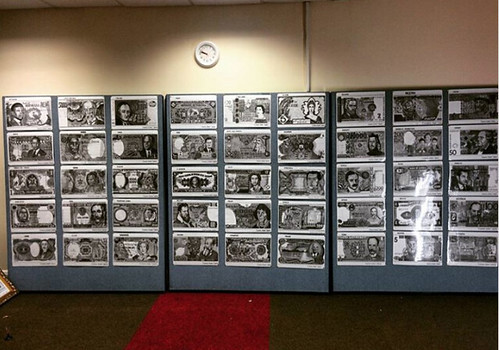
To read the complete article, see:
Nigerian Artist Perfectly Recreates Old Maltese Banknote In
Painstaking Detail (https://lovinmalta.com/lifestyle/nostalgia/nigerian-artist-perfectly-recreates-old-maltese-banknote-in-painstaking-detail)
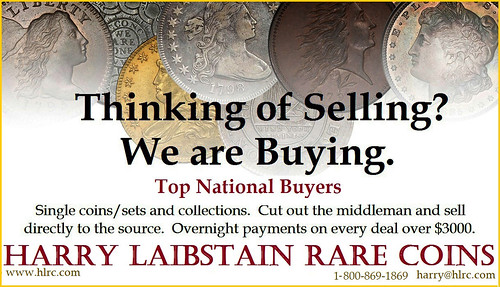
SRI LANKA'S NEW DIVERSITY BANKNOTE
Kavan Ratnatunga writes:
Sri Lanka has gone beyond "In God we Trust" by putting icons of Buddhist, Hindu, Christian and Muslim religions on the new Currency Note issued to Celebrate Diversity on the 70th Anniversary of Sri Lanka Independence on 2018 Feb 4th
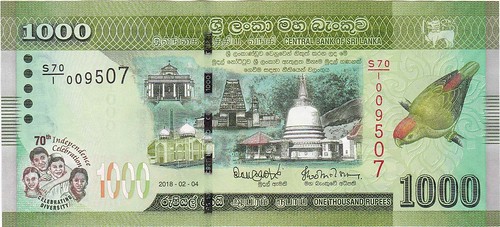
The Central Bank of Sri Lanka has issued a modified One Thousand Rupee currency note dated 2018-02-04 to commemorate the 70th Anniversary of Independence with the theme “Celebrating Diversity”.
The image of Ramboda Tunnel at the centre of the current Rs. 1000 note has been replaced by a montage of an artist’s impression of a vihara, kovil, church and mosque. Replacing the butterfly on the lower left corner, is a logo with a Sinhala boy, a Muslim boy with hat, a Burgher girl with red hair to left and a Tamil girl to the right. The words 70th Independence Celebration in upper right and CELEBRATING DIVERSITY are seen at the bottom. Does this logo represent more than Diversity of Race and Religion?
It is the first currency note to circulate with the signature of the Minister of Finance Mangala Samaraweera, and was issued to public circulation on February 6. 5 Million notes have been printed by De La Rue at Biyagama,with Serial prefix S70 and 5000 of them issued in commemorative folder printed by Print Care are available for salefrom the CBSL Economic History Museum for Rs 1300.
To read the complete article, see:
Celebrating diversity: Modified Rs. 1000 note for Independence
(http://www.sundaytimes.lk/180211/plus/celebrating-diversity-modified-rs-1000-note-for-independence-281099.html)
For more information on the note, see:
2018 - Sri Lanka - 1000 Rupee note 70th Independence - Celebrating Diversity
(http://notes.lakdiva.org/commemorative/2018_ind70_1000r.html)
MALAWI PRAYS PEOPLE WILL STOP ABUSING BANKNOTES
The Reserve Bank of Malawi (RBM) has asked religious leaders in the country sensitize their follows to desist from mishandling the banknotes.
This comes at a time the Bank is concerned that it uses between MK10 billion and K15 billion every year to replace damaged banknotes.
In the letter, RBM Governor, Dalitso Kabambe, cites the practice of stepping over banknotes, placing banknotes under wet conditions in fresh fish and vegetable markets, using soiled hands, keeping banknotes in socks and smelting coins for repairing bicycles, as some of the regrettable practices.
“Such malpractices damage our currency and are costly to the bank,” Kabambe said.
RBM, therefore, expresses willingness to join hands with the church community in dealing with the malpractices.
“We strongly believe that the church is one place where the bank can be assisted in advancing its noble cause. The church also stands to benefit from this exercise as we understand church leaders spend hours on end unfolding and straightening banknotes after collections,” he said.
To read the complete article, see:
Malawi religious leaders asked to preach against the mishandling banknotes
(http://www.maravipost.com/malawi-religious-leaders-asked-preach-mishandling-banknotes/)

The Saudi Public Prosecution appealed to the public, urging them not to tamper with bank notes they are using in their daily transactions.
It launched an awareness campaign, warning that violators would face legal measures, according to Akhbar 24.
Lawbreakers convicted of defacing notes would be jailed up to five years and handed down fines which could reach SR10,000.
The penalties would apply to lawbreakers who tear bank notes, deface them using chemical substances or destroying them partially.
To read the complete article, see:
Saudi warns against tampering with banknotes
(http://www.gdnonline.com/Details/317031/Saudi-warns-against-tampering-with-banknotes)
BELGIAN STATUE SOAKS UP KNOWLEDGE
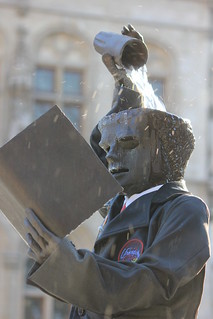 Fons Sapientiae, nicknamed “Fonske,” is well-loved resident of Leuven. The whimsical statue is an ode to the city’s rich student life. The name translates to “Source of Wisdom,” and
the water the man pours atop his head is supposedly meant to symbolize knowledge flowing into his brain. An intricate math formula is scrawled across the front cover of the book he clutches that,
when solved, forms the Dutch word for “happiness.”
Fons Sapientiae, nicknamed “Fonske,” is well-loved resident of Leuven. The whimsical statue is an ode to the city’s rich student life. The name translates to “Source of Wisdom,” and
the water the man pours atop his head is supposedly meant to symbolize knowledge flowing into his brain. An intricate math formula is scrawled across the front cover of the book he clutches that,
when solved, forms the Dutch word for “happiness.”
Some students, however, interpreted the statue in a more lighthearted way. Instead of knowledge, they imagined booze sloshing from the tipped cup; a nod to the notorious drinking culture that surrounds most universities (and perhaps to the many breweries that call the city home). They continually add their own fun, flashy additions to their beloved Fonske by dressing it up in various costumes throughout the year.
To read the complete article, see:
Fons Sapientiae (https://www.atlasobscura.com/places/fons-sapientiae)
IN OTHER NEWS: FEBRUARY 11, 2018
Fake 1852 Quebec Bank Token
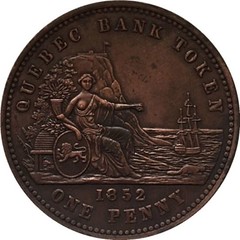 According to some collectors, it appears counterfeiters have taken to faking Canadian pre-Confederation tokens.
According to some collectors, it appears counterfeiters have taken to faking Canadian pre-Confederation tokens.
“Just looks wrong—too strong details, and appears to have beads (legitimate ones have denticles). And most of the seller’s other listings appear to be fakes...
To read the complete article, see:
Counterfeiters making fakes of pre-Confederation tokens, say collectors
(https://canadiancoinnews.com/counterfeiters-making-fakes-pre-confederation-tokens/)
The Royal Mint's New Service
With countries moving to cashlessness, what’s a mint to do to stay relevant in the 21st century?
The Royal Mint announced it has decided to offer a service that might be considered competition with third-party grading services.
Should numismatic private enterprise be worried?
Probably not.
To read the complete article, see:
Can new British mint service possibly succeed?
(http://www.numismaticnews.net/buzz/can-new-british-mint-service-possibly-succeed)
U.S. Men Arrested For ATM "Jackpotting"
The United States Department of Justice (DOJ) has charged two men with bank fraud after they allegedly hacked ATM machines causing them to eject all their cash reserves like a Vegas slot machine. The
attack, known as “jackpotting,” is usually carried out by perpetrators dressed as repair technicians to deploy malicious software and/or hardware, while others then exploit the hack to withdraw the
cash on demand.
To read the complete article, see:
US charges two men over ATM ‘jackpotting’
(https://www.theverge.com/2018/2/6/16977794/department-of-justice-doj-charges-two-men-atm-jackpotting-malware-hack)
To read the earlier E-Sylum article, see:
HACKER JACKPOTS: ATMS SPIT OUT THEIR BANKNOTES (http://www.coinbooks.org/v21/esylum_v21n04a37.html)
FEATURED WEB SITE: ORIENTAL COINS DATABASE
This week's Featured Web Site is Zeno.ru, the Oriental Coins Database.Zeno.ru is one of the oldest coin web sites on the 'net, begin in December 2002. It holds over 197,000 photos.
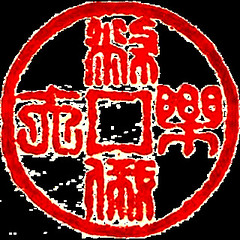
https://www.zeno.ru/

